

| Eakring Birds |
| Systematic list and ten year summary 1998-2007 |
| The systematic list features all 171 species, recorded in the Eakring and Kersall area between 1998 and 2007. Wherever possible, I have kept the accounts as brief as ten years of records would allow. | ||
| .... | .... | .... |
| However, some species
accounts have been extended, especially where it was felt
neccessary to give a more detailed account of that
species' occurrences over the past ten years.
The accounts feature numerous photographs and graphs showing migration patterns, peak occurrences and breeding successes. Earliest arrival dates for both Summer and Winter migrants are also provided. At the end of 2007, the Eakring area had a total of 175 species on it's list. This includes just four species which have been known to occur historically, but for which there have been no records since before 1998. These are Corn Crake, Nightingale, Wryneck (Kersall 1984) and Pied Flycatcher (Eakring 1996) |
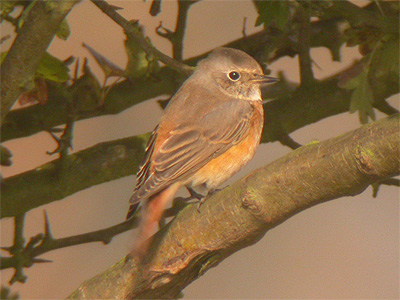 |
|
| .... | .... | .... |
| Both Corn Crake and Nightingale have not occurred for many years now, but there are some people still living in Eakring, that can remember the days when these two species were a common sound of the area during the Summer months. The past ten years have actually produced 171 species. I have not seen them all and actually missed the Leach's Storm-petrel in October 2003, by being at Eakring Meadows when it was flying over Eakring Flash and then missed the Great Grey Shrike at Eakring Flash in October 2004. | ||
| Systematic bird list 1998-2007 | ||
| Little Grebe Tachybaptus ruficollis |
| Formerly regular at Eakring Flash, rarely at other sites in the area. One present on floodwater at Penny pasture Common several years ago, was an unusual record. Recent years have seen a considerable drop in the number of records and there was just a single record in 2007. Breeding has been recorded twice at Eakring Flash, but only once was a pair successful when they reared one young to maturity. |
| Black-necked
Grebe Podiceps
nigricollis |
| Just one record of a single bird present at Eakring Flash from July 10-17th 1999. |
| Great Crested
Grebe Podiceps
cristatus |
| An adult at Eakring Flash from May 20-June 2nd 2006, ended a near nine year wait for this species and is the only record. |
| Leach's
Storm-petrel
Oceanodroma leucorhoa |
| A single bird was at
Eakring Flash briefly on October 5th 2003 and found by
Robin Brace and Tony Wardell. The bird came in from the north-east at 10:40am. Wind was moderate north-westerly with almost unbroken sunshine. It was already quite close when first observed and went directly over both observers at it's closest approach, with views to within 25-30m - and then headed towards Eakring village. It was then 'pestered' by a corvid and descended close to the ground in the pastures area and was lost to view behind the hedge. It re-appeared briefly over same hedge, but was then lost behind trees and not seen again. |
| Cormorant Phalacrocorax carbo carbo |
| Noted fairly regularly and most often recorded away from the breeding season, with most sightings involving birds commuting from the Trent valley to other local waters in the area. Uncommon to be seen fishing Eakring Flash. A "sinensis" Cormorant on February 7th 2002, was the area's only record. |
| Grey Heron Ardea cinerea |
| Has been present on an almost daily basis since 1998. There have been no breeding attempts within the area and most of the records probably involve birds flying over from Rufford CP. |
| White Stork Ciconia
ciconia |
| One ringed with the letters A.J. was present in fields near Eakring village from November 25-December 13th 2003. It's origin has justifiably been questioned and this bird was certainly an escape. | ||
| Mute Swan Cygnus olor |
| Mute Swans have never bred successfully here, despite a number of birds taking up residencies over the years. One pair, consisting of an adult male and an immature female, attempted breeding in 2000 but eventually failed despite some egg incubation. |
| Bewick's Swan Cygnus columbianus |
| Surprisingly just the one record in ten years despite this being a fairly rare species in Nottinghamshire. A family party of two adults and two juveniles were at Eakring Flash from November 30-December 6th 2001. The group also visited other sites outside the recording area and could go missing for more than a day at a time. Although Bewick's Swan was always an expected species here, it was generally expected as a fly-over record only. |
| Whooper
Swan Cygnus
cygnus |
|||||
|
|||||
| .... | .... | .... | |||
| Bean Goose Anser fabilis |
| Just one record of a single bird flying west over Eakring Meadows on March 27th 1998. |
| Pink-footed Goose Anser brachyrhynchus |
| Regularly
recorded as birds relocate to areas on opposite sides of
the UK, most often during the months of October,
November, January and February. Directional movements are
usually to the east in Autumn, with birds returning
north-west in the early months of the year. A total of 12
656 Pink-footed Geese have been counted
here between 1998 and 2007. The highest ever single day count was 1 833 moving south-east on October 26th 1999. Other high counts were 624 north-west on February 14th and 713 flying east and south-east on November 16th 2003 |
| White-fronted
Goose Anser
albifrons |
| A flock of 11 moving south-west on November 17th 2001, is the only record to date. |
| Greylag Goose Anser anser |
| Usually recorded in small numbers and mostly in March-May, as pairs search for suitable nest sites. However, Greylag Goose has yet to attempt breeding in the area. |
| Canada Goose Branta canadensis |
| Common, although not as regular as might be expected. Has bred at Kersall Pond and made just one failed attempt at Eakring Flash. |
| Egyptian Goose Alopochen aegytiacus |
| Rare here with just five records. Two were at Eakring Flash on April 27th 2000, whilst the last record was of five over Eakring Flash on September 17th 2005. In 2003 there were three seperate Eakring Flash records, including a single on April 25th, eight on August 11th and four on September 25th. All birds are though to have originated from the Rufford CP area. |
| Shelduck Tadorna tadorna. |
| I was surprised when Shelduck first appeared here in 1998, but this duck has been a regular feature of the first part of the year since. The first birds usually turn up in January (occasionally February) and although a pair appear regularly until around May, much of the time they spend out of the area and breed elswhere. Nine young were successfully hatched at Eakring Flash in June 2002, but only one of which ultimately survived. The highest site count was of 11 at Eakring Flash on June 2nd 2001. |
| Mandarin Duck Aix galericulata |
| Not seen since 2004, with an unusually large number of records coming in 2002 when breeding almost certainly occurred although the actual nest site was never located. The pair produced four young and (like many Mandarin records here) were all from the Eakring Meadows area. Occasional records have come from Eakring Flash including drakes on November 25th 1998, August 28th 2002 and December 5th 2004. |
| Wigeon Anas penelope |
| This duck has become
increasingly scarce, possibly as a result of vegetation
growth around Eakring Flash, making it more unsuitable.
The number of records have dropped steadily since 2002,
with both 2004 and 2005 producing just two records
apiece. There were no Wigeon seen at all in 2006 and just
one in 2007. Wigeon have typically produced the greatest numbers during the early Autumn, with the first birds at Eakring Flash usually appearing in September. The earliest Autumn date is July 19th 1999 and there is also one other July date. Wigeon are rare here during the early months of the year, with occasional records coming in February and usually involving pairs. The highest ever count was a flock of 60 moving west over Eakring Flash on September 11th 1999. |
| Gadwall Anas strepera |
| Potential breeding
Gadwall arrive in the area during January, with peak
counts usually coming during February. A gradual decline
follows throughout the year, although monthly counts in
August and September are slightly inflated by the
inclusion of young reaching the flight-stage. Gadwall
have bred every year and for a couple of years even
outnumbered Mallard, but 2007 represented a poor year for
all breeding wildfowl. An extremely high count came in 1999, following an overnight arrival of 35 at Eakring Flash on September 1st, with numbers peaking a few days later at 46 on September 4th. The only other similar count, was of 30 on Eakring Flash, January 20th 2005. |
| Teal Anas crecca |
|||
| Teal numbers reached a pronounced peak of 150 at Eakring Flash in January 2002. This kind of build up has never been repeated and is possibly as a result of the trend towards increasingly milder Winters. | ||
| .... | .... | .... |
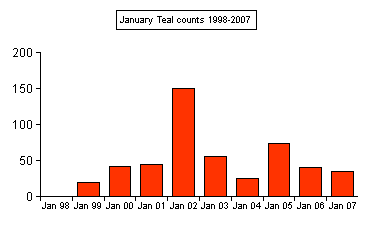 |
Teal have returned in far
fewer numbers to the Eakring area since and over the last
few years, birds have favoured the small pool on Penny
Pasture Common to Eakring Flash. Summer records are not
uncommon and there have been six records in June, but not
since 2004. Summer records are a pair at Eakring Flash
June 2nd 1998; three drakes at Eakring Flash June 15th
1999; a drake at Eakring Flash June 24th, with two drakes
present from June 25th and into July 2000; two drakes and
a female at Eakring Meadows June 3rd 2002 and a drake at
Eakring Flash June 12th 2004. The first returning birds have occurred from late July, but it's usually mid-August onwards. Numbers fluctuate during September and October and the first real influxes follow the onset of colder weather. |
|
| .... | .... | .... |
| Mallard Anas platyrhychos |
| A common species, although it has become much less so in recent years. Almost any area of water in the area has held at least one breeding pair at sometime and the highest ever count was from Eakring Flash, where there were 136 on November 3rd 1998. |
| Pintail Anas acuta |
|
| Rare here with just four Autumn records. Two were at Eakring Flash on October 7th and a male again at Eakring Flash on November 17th 2001. A single bird was at Eakring Flash briefly on September 22nd 2003 and six (including two drakes) were at Eakring Flash from first light, but soon departed west on September 27th 2007. | |
| Garganey Anas querquedula |
| Juvenile Garganey have occured twice during the last ten years. Both records have come from Eakring Flash on August 7-9th 1999 and August 18th 2002. |
| Shoveler Anas clypeata |
| An uncommon visitor to
Eakring Flash, Shoveler were annual until 2005 but there
have been no records since. Three at Eakring Flash September
13th 2003 is the highest count. All the areas Shoveler records are listed
below. One at Eakring Flash August 26th 1998; One at Eakring Flash August 29th; A male moving east October 24th 1999; A female at Eakring Flash August 31-September 1st and again on September 9th 2000; An eclipse drake at Eakring Flash on September 25th and 29th; A pair at Eakring Flash October 10th; Two eclipse drakes October 13th 2001; One moving north over Eakring Flash September 5th; A pair at Eakring Flash November 21st 2002; Two at Eakring Flash September 9-12th; Three at Eakring Flash September 13th; One at Eakring Flash October 10th 2003; One at Eakring Flash August 31st 2004; Two males at Eakring Flash February 20th; One at Eakring Flash August 11th 2005. |
| Pochard Aythya ferina |
| Yet another duck which has shown a reduction in records since 2004, which culminated in failing to produce even a single record after March 2007. Highest monthly counts have been 19 in February 2003, 15 in March 2003, 13 in September 2001 and finally 12 in both January and November 2002. |
| .... |
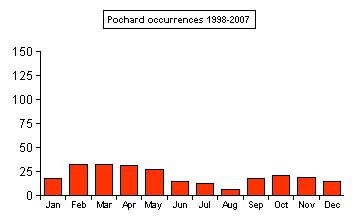 |
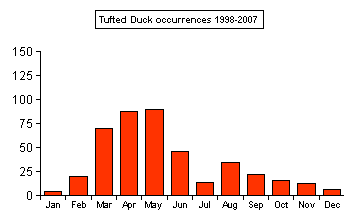 |
|
| .... | .... | .... |
| Tufted Duck Aythya fuligula |
| Tufted Duck have been regular breeders at Eakring Flash and also at Kersall Pond on occasions. Numbers traditionally rise from either February, peaking in April and May. Young appear later than most other ducks, accounting for the slight rise in monthly counts from August onwards. Rare and unusual here in December and January. |
| Goldeneye Bucephala clangula |
| Another very rare duck here, with just two records. A female and a 1st winter male were at Eakring Flash on October 29th 2000 and remained the only record until six arrived overnight at Eakring Flash on the strange date of July 16th 2006. |
| Goosander Mergus merganser |
| Goosander have always
been regular visitors to Eakring Flash, producing
numerous records from December-March most years. The only
poor year came in 1999 when there were just three records
during the early part of the year. The first Goosander occasionally arrive from mid-November, but it's usually during cold weather at the end of December, before the number of records increase in regularity. The earliest bird was on October 28th 2003 and there have been a couple of records in May, with ten north-east over Eakring Flash, May 5th 2004 and a female moving north-west, May 20th 2006. Highest counts came in 2005, producing a maximum of eight at Eakring Flash on March 3rd and seven on March 6th. |
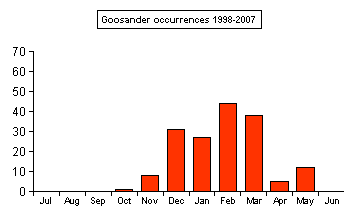 |
|
| .... | .... | .... |
| Ruddy Duck Oxyura jamaciensis |
| Following the national cull by DEFRA, it is doubtful whether there are sufficient numbers left for one to turn up here again. There has never been any Ruddy Duck at Eakring between November and January, typical first arrivals often not appearing much before May. Despite there frequently being at least a pair at Eakring Flash during the Summer months, breeding was never proven to have taken place. At present, the last record of this species was of two long-staying males present at Eakring Flash until July 16th 2006. |
| Honey Buzzard Pernis apivorus |
| Four records in the past ten years, including an adult drifting east over Hare Hill Wood on August 22nd 1999, one moving south over Red Hill on September 23rd 2000, an adult in the Eakring Meadows and Hare Hill Wood area from August 27-September 13th 2002 and one south over Red Hill on September 7th 2003. |
| Red Kite Milvus milvus |
| A total of nine records including an extremely elusive individual which made a prolonged stay from March 23-April 15th 2003. Other records were as follows. A wing-tagged bird drifted north-west over Lound Wood/Red Hill on September 25th 1999, an immature spent much of the morning in the Hare Hill Wood area on September 3rd 2000, before it eventually drifted off north towards Laxton. Later in the same year, there was another bird at Church Hill on December 23rd. One flew north-west early morning over Eakring Flash on March 8th 2002 and one was in the Lound Wood/Leyfields area, before eventually drifting off south-east on August 16th 2004. There was a record of two birds which eventually flew off north over Red Hill on April 7th 2005, one moving west near Wellow on June 10th 2006 and finally, one at Tug Bridge Farm, eventually drifted off north over Park Farm on April 21st 2007. |
| Marsh Harrier Circus aeruginosus |
| Formerly an annual
passage migrant with 11 records concerning 12
individuals, but not seen here now since 2004. Three
Spring records came on April 27th 1998, April 25th 2000
and May 16th 2002. Not surprisingly there has been a much better showing in the Autumn. August has produced records of five individuals including two seperate birds on August 21st 2002. One of these spent some time perched in the dead trees in the centre of Eakring Flash, before being driven off by corvids. The other August records were on August 8th 2000, August 12th and 18th 2003. September has produced birds on September 24th 2000, September 4th 2001 and September 4th 2004. The sole July date was July 27th 2003. |
| Hen Harrier Circus cyaneus |
| Very rare
here with just three records. All three records though
involved birds that stayed for several days or more, but
all were very elusive and covered large areas of
farmland. A male was at Eakring Flash and then noted in
the Park Farm/Eakring Meadows area, from March 5-27th
1999. This bird was seen several times in the Eakring
Flash/Eakring Meadows area by locals and is also believed
to be the bird seen regularly throughout the Winter by
Thoresby Estate gamekeepers near Laxton. It was another five years before Hen Harier was recorded in the area again, when another male was present in the Park Farm/Eakring Meadows area, from March 29-31st 2004. A female/immature was at Eakring Flash on February 5th and then a week later at Eakring Meadows on February 12th 2007. |
| Montagu's Harrier Circus pygargus |
| A male drifted south over Eakring Flash on May 3rd 2005, the sighting coinciding with a good influx nationally of Black Kites and smaller numbers of Montagu's Harriers. |
| Goshawk Accipiter gentilis |
| Very rare with three records. A male at Lound Wood on December 26th 1998, a female at Lound Wood March 24th 2001 and one near Eakring Meadows on November 13th 2004, being the only records. |
| Sparrowhawk Accipiter nisus |
| Up to two pairs have bred in the area most years. Possible migrants have been noted moving high south during known periods of raptor migration in the Autumn. |
| Common Buzzard Buteo buteo |
| Common Buzzards have
always been regular birds here and over the years, the
number of birds and sightings has shown a gradual
increase, eventually peaking at a remarkable 14 together
in the Red Hill area on September 23rd 2007. Breeding first took place in 2004, when a pair successfully raised two young. This was apparently being the first time that Common Buzzards had bred here since the early 1990's and was certainly the first time since 1998. The same pair has since gone on to breed again in 2005, 2006 and 2007. Typically there are one or two birds regularly in the area at any one time and these are frequently joined by birds from the Kirklington, Laxton and Rufford areas nearby and also by genuine migrants. |
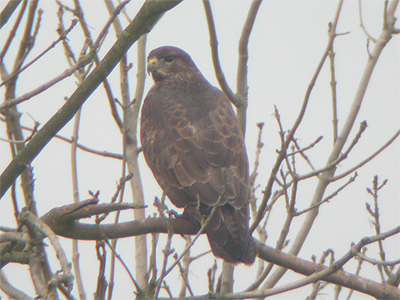 |
|
| .... | .... | .... |
| The accurate determination of genuine migrants is often difficult, but there heve been instances when this was possible. In 2005 there was an excellent passage of Common Buzzards through the area between May 10-15th. A minimum of 13 birds were involved, most of which were seen moving high north or north-east. Individuals/sightings were; one high north (10th) three single birds moving high north and two going south-east on (11th) three birds heading high north-east (12th) two north-east (13th) and finally two on 15th. Autumn migrants have been far more frequent, with most seen to come in from the north-east. Like Spring migrants, these often 'thermal' with resident birds before moving on. | ||
| Osprey Pandion haliaetus |
| A total of eight records, Osprey has always been erratic in it's occurrences here. The first was one drifting south-east over Eakring village on April 28th 1998. In 1999 there were records during both migration periods when one was fishing near Red Hill, then eventually flew off north, April 22nd 1999, followed in the Autumn by one at Eakring Flash which moved off high south on September 21st. Two records came the following year with one moving north-east over Leyfields/Lound Wood on April 16th and one south-east over Eakring Flash on September 24th 2000. One moving south over Eakring Flash on August 24th 2003, was the only record for the year and it wasn't until April 2005 that singles moved north-west over Eakring village April 9th, followed by one moving north over Eakring Flash on April 11th. |
| Kestrel Falco tinnunculus |
| Common, with almost daily sightings. A pair have bred near Eakring Flash since 1998, with another pair near Kersall since 2001. |
| Merlin Falco columbarius |
| Merlin has always been
particularly scarce and erratic in it's appearances at
Eakring. However, over the past few years there has been
a decided increase in the number of records produced per
annum. By the end of 2007, a total of 20 different Merlin
had been recorded. The period 1998 through to and including 2003, only managed to produce single records, apart from two in both 2001 and 2003. The only blank year for Merlin came in 2004. At this stage Merlin remained an extremely difficult species to catch up with here, but that changed with three late Winter/early Spring records in 2005. This meant a real increase in the number of sightings over previous years and the same number of records was repeated again in 2006. There were five records in 2007, making it the best year for the species. |
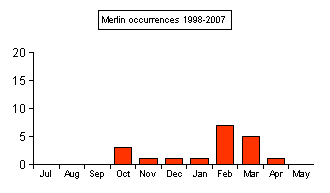 |
|
| .... | .... | .... |
| February is by far the peak month for Merlin here and presently accounts for approximately 50% of all early year records. This is quickly followed by March and then later in the year by October. All three month's totals are likely to involve migrant birds returning to and from their northerly breeding ranges. Single records for November, December and January, relate to wandering or wintering birds. | ||
| Hobby Falco subbuteo |
||||||||||||||||||||
| Arrival dates 1998-2007 | ||||||||||||||||||||
|
||||||||||||||||||||
| A regular passage migrant with possible breeding occurring in some years. Single adults with a fully fledged young have been noted regularly and have remained in the area for several weeks on occasions. The earliest arrival date was on April 15th 2007, but the first birds have appeared on April 29th in four seperate years and both April 24th and May 3rd in two years. The latest date for Hobby is October 1st 2000. Both 2005 and 2006 represented poor years with relatively few sightings. | ||||||||||||||||||||
| Peregrine
Falcon Falco
peregrinus |
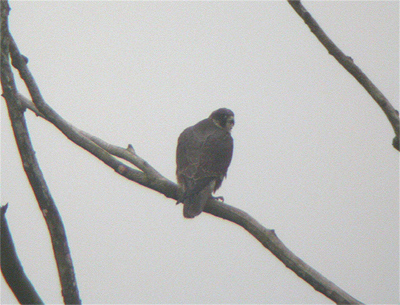 |
Peregrine have proved to
be relatively common and there were birds seen most
months outside the breeding season. Inclusive dates for
first and last birds are April 26th 2000 and 2001 and
July 25th 2004. Occasionally birds have spent several days in the area and one particular female which arrived as an immature bird in December 2002, subsequently returned each Winter until March 2007, but failed to return later the same year. A recent long-staying individual was an immature male which favoured the Eakring Flash/Leyfields area from September 21-December 25th 2007. Photographs of this bird in trees at Eakring Flash, later showed that this bird had been rung. |
|
| .... | ||
| Red-legged
Partridge Alectoris
rufa |
| Has always been common, but has recently shown a significant decrease in numbers. |
| Grey Partridge Perdix perdix |
| One of the area's most
threatened farmland species, Grey Partridge have done
increasingly well over the past ten years, as a direct
result of the introduction of set-aside strips. These
provided safer areas for birds, suitable nesting sites
and cover for newly-fledged young. With a change in
farming practices, farmers no longer cultivated or
sprayed herbicides up to the field boundary and
mechanical disturbance to nesting areas is now more
commonly associated with hedge-trimming from July
onwards, rather than through crop cultivation procedures.
In the late 1990's, accumulated area counts only ever reached double figures on one occasion and coveys totalling more than seven birds were rare, but by 2003, the wintering Grey Partridge population ranged from 17-20+ birds. Counts continued to show an increase and by late 2007, the wintering numbers were believed to be around 30 birds. |
| Quail Coturnix coturnix |
| Quail were recorded in four years. In 1998
there were records of a male at Eakring Field
Farm/Eakring Meadows on May 20th, with two males noted
calling from the same area on May 21-25th. Four males
were then present from May 26-June 2nd. Record numbers of Quail were then present in 2001, attracting numerous listeners on fine evenings during their lengthy stay around both Tug Bridge and Eakring Field Farms. Contrary to popular belief, these birds had not been released for shooting. These birds were meticulously mapped throughout the Summer and it was found that there was a genuine pattern to the arrivals of further birds. All arrivals occurred during anti-cyclonic weather and light easterly winds. The first calling male was in Oil Seed Rape at Eakring Field Farm from May 26th, with a second bird present at nearby Parkhill Plantation from May 29-June 7th. On June 8th, a third bird was discovered in the Eakring Meadows area, calling distantly from the stubble field opposite the Kersall end of the reserve. This bird was rarely noted after it's initial discovery. June 10th saw another influx take place, when a total of seven birds were found calling at Eakring Field Farm, Parkhill Plantation, Penny Pasture Common.and two sites along the Kneesall Road. By the 18th, some nine males had been located. |
||
| .... | .... | .... |
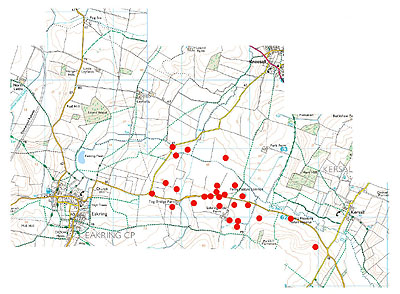 |
Positional mapping of
these males, helped to determine their movements and
territories during this time. Checking sites away from
roadside locations proved fruitful on the 20th, when two
more males were located in the sprayed set-aside to the
south-east of Eakring Field Farm. These, with a further
two new arrivals by the roadside in front of the farm,
mean that at that time, some 14 males had been located in
the area (seven of which were now situated at Eakring
Field Farm) Some movements by certain males were suspected to have taken place. Two of the Tug Bridge Farm birds, were considered to be accountable for the new males which arrived at nearby Eakring Field Farm. This theory was dispelled however, when all the original Tug Bridge Farm birds, plus one new arrival began calling again on June 25th. What was now clear though, was that despite failing to call for many days, males remained in territories attained on arrival, rarely venturing more than fifty yards or so. Continued monitoring now showed that the full total of males had now reached 17 birds. |
|
| .... | .... | .... |
| July saw
another series of arrivals. Following on from a new bird
found near Parkhill Plantation on the 1st, the total
crept up to 18 males. With high pressure and easterly
winds dominating proceedings during the first few days,
conditions were similar to that which led to the arrivals
of mid-June. On July 4th, another major arrival took
place and nine new, actively calling males were found. As
such, the total now was 27 males. Allowing for a female
count of perhaps another 15 birds, then the total
probably touched over 40. This however was obviously
conjecture, but such a total must have been highly
probable. Birds remained in their respective areas after arrival and territories were found to be suprisingly small, probably little more than 50 square yards. Calling was most consistant and energetic from arrival and for a period of around 4/5 days. It was found that periods of song from long-staying males, gradually shortened (sometimes to only two or three times an evening) a week after arrival and that in all cases, males often ceased to call entirely for lengthy periods (sometimes lasting for over a week) leading to the impression that the birds had left the area. In most cases however, influxes of new birds, produced a resumption (though quite short-lived) in active calling from earlier arriving males. Both major arrivals, on June 10th and July 4th, occurred during spells of fine warm weather and easterly based winds, associated with high pressure systems over the UK and nearby Continent at the time. Quail remained in the area well into August, when calling males were heard at Eakring Flash briefly on the 18th. These records clearly relate to birds which relocated, after the harvesting of crops around Eakring Field and Tug Bridge Farms. The following year, a single male was calling near Lound Wood on June 25th 2002. There were no further records till 2005, when a male arrived at Eakring Flash on May 12th, with two males present at Eakring Flash from May 13-15th. |
||
| Pheasant Phasianus colchicus |
| Very common, with large numbers being released for shooting purposes. |
| Common Crane Grus grus
|
| One record, involving a single bird moving north-east over Eakring Flash on March 22nd 2000, which was particularly notable for the influx of Common Cranes into the UK, including eight reported sightings of birds within Nottinghamshire alone. |
| Spotted Crake Porzana porzana |
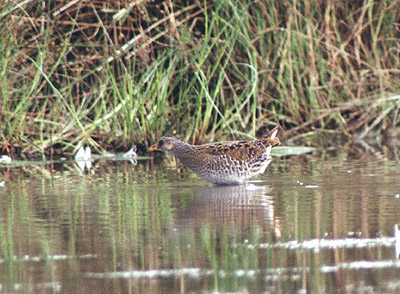 |
One record of an adult
female, present at Eakring Flash from August 16-September
15th 2001. It's discovery attracted the area's largest
number of birdwatchers for any one bird. It is thought
that well over 200 admirers saw it during it's lengthy
stay, when it frequently showed for lengthy periods,
mostly at the southern-end of Eakring Flash. What certainly surprised many people, was the fact that such a small area of water could attract a Spotted Crake in the first place, yet the habitat at the time was more than suitable and this was a species that I had personally always considered likely. It was also the longest staying of any Spotted Crake recorded to date in Nottinghamshire and there were several others at many other sites across the UK at the time. |
|
| .... | .... | .... |
| Water Rail Rallus aquaticus |
| The first record of Water
Rail here, was at Penny Pasture Common, Eakring Meadows
from October 3-7th 1999, quickly followed by what may
have been the same bird, present at Eakring Flash from
October 24-November 30th. Water Rail became annual
visitors to Eakring Flash from then on. When Eakring
Flash becomes completely frozen, Water Rail tend to be
found along The Beck, occasionally being recorded from
the filter beds at Eakring village STW. One at Eakring Flash on September 2nd 2002, is the earliest Autumn date. Birds have rarely stayed much later than February, but there are a couple of records for March, including singles at Eakring Flash from March 21-30th 2004 and March 11-24th 2006. Three at Eakring Flash on November 2nd 2007, is so far the largest proven count. |
| Moorhen Gallinula chloropus |
| Common, with pairs found at most areas of water. |
| Coot Fulica atra |
|
| Coot very rarely over-winter here and typically, the first arrivals at Eakring Flash occur in mid-January. Numbers build up quickly if the weather remains mild and waters ice free, to reach a breeding population for the area of around eight pairs most years. By late August, many birds have already left the area and dispersing birds have been heard nocturnally on numerous occasions, well away from water. | |
| Oystercatcher Haematopus ostralegus |
| A total of nine records, with three of these relating to nocturnal passage/movement. Some of the area's records have involved birds wandering from the Bilsthorpe pit top area. All records have come during either April (3) June (4) or August (2) |
| Little Ringed
Plover Charadrius
dubius |
| Little Ringed Plover has
been recorded annually since 1998, but with a rise in
water levels and an increase in vegetation at Eakring
Flash in 1999, this has now become a scarce wader here,
with just a handful of records each year. In 1998 there
were numerous records including a pair which made two
failed breeding attempts at Eakring Flash. The pair were
present from April 27th and eventually left the site on
July 12th. 1998 saw a total of 12 Spring records, with another six birds in the Autumn, between two juveniles on July 25th and a single moving south September 12th. Since then, all of the 22 records up to 2007, have involved brief passage birds with April taking up the bulk of the records. |
| Ringed Plover Charadrius hiaticula |
| Ringed Plover have proved to be extremely scarce here with just six records. These include two at Eakring Flash May 21st, one moving south over Eakring Flash on August 22nd, one moving west over Eakring Flash on September 5th 1998, two moving west over Eakring Flash, July 17th 2002, two moving north over Eakring Flash on April 28th 2004 and two moving north over Eakring Flash on April 1st 2007. |
| Golden Plover Pluvialis apricaria |
| Recorded regularly here in numbers which vary according to season. Golden Plover flocks have most often built up during the early Autumn, but these typically move to over-winter in other parts of the county, till smaller numbers begin to reappear in March. There are occasional birds noted in April and May. Throughout the ten years, there have been just two counts over 500, with flocks of approximately 696 near Red Hill on March 5th 1999 and 918 at Church Hill on October 9th 2003. |
| Grey Plover Pluvialis squatarola |
| A juvenile was in fields with Golden Plover near Church Hill on October 29th 2000 and one flew west over Eakring Flash with a small group of Golden Plover on October 17th 2002, were the only records. |
| Lapwing Vanellus vanellus |
| Very erratic here as a
breeding bird and not unknown for no pairs to breed some
years. Through the lack of any permanent breeding
habitat, Lapwing have seemed forced to adopt an
opportunistic approach to nesting and were entirely
dependent on the correct habitat being available for any
breeding success. The variation on numbers of breeding
Lapwing was due to the annual variations in suitable
habitat availability caused by crop types/growth. Between
1998 and 2001, the preferred nest sites of 14 pairs out
of 15, were in predominantly open, bare or sparsely
vegetated set-aside or germinating Sugar-Beet crops. 450 in fields north of Red Hill on February 9th 2001 and 278 at Eakring Field Farm/Eakring Meadows September 4th 2004, were the largest counts by far. Lapwing have proved to be one of the few species to produce regular movements associated with cold weather during the Winter, with 1 290 noted moving south-west between December 28-31st 2000. An aberrant Lapwing seen on October 14th 2002, lacked any green pigmentation in its feathers. |
| Dunlin Calidris alpina |
|
| There have been 18 records, all concerning passage birds and six of which have occurred in August and four in September. Two Winter records were single birds at Eakring Meadows briefly on January 5th and on flood-water near Eakring Flash on January 21st 2003. One in fields with a Golden Plover flock on September 21st 2003 was an unusual record. | |
| Ruff Philomachus pugnax |
|
| Just four records. Four moved north over Eakring Flash on August 31st and a male was briefly at Eakring Flash, before it left high south-west on September 19th 2001. A single bird was present in fields with a Lapwing flock at Eakring Flash on September 5th 2002 and finally, one moved north-east over Eakring Flash on July 28th 2005. | |
| Jack Snipe Lymnocryptes minimus |
| Regular during the Winter
months with the majority of Jack Snipe records coming
from Eakring Meadows, with just four from Eakring Flash.
There are two noticeable periods of occurrence for Jack
Snipe. The first arrivals have usually appeared in October and November, then followed by a lack of records in December. The peak months for Jack Snipe have always been early in the year, most especially in February. Notable counts have been five at Eakring Meadows from March 6-11th, with six at present on March 12th 2002 and six again at Eakring Meadows on February 6th 2005. |
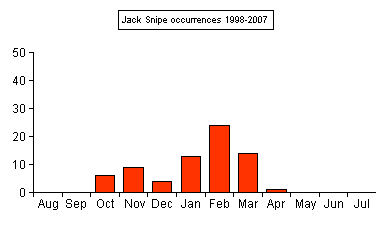 |
|
| .... | ||
| Common Snipe Gallinago gallinago |
| Occurs regularly at Eakring Flash, but Eakring Meadows has always produced the highest numbers. Despite some suitable habitat, Snipe have never attempted breeding here. The highest counts were 34 moving west in two flocks on August 19th 1998, whilst 39 at Eakring Meadows on February 15th 2002, rose to 42 by February 21st. With smaller numbers at Eakring Flash, at least 48 were in the area on this latter date. |
| Woodcock Scolopax rusticola |
| Largely an uncommon Winter visitor here, but single males did occupy territories at Lound Wood in 2003 and 2004 and at Hare Hill Wood in 2004, although no evidence of breeding was found. There are four November records (usually following arrivals on the east coast) closely followed by return migrants appearing in February with three records. |
| Bar-tailed Godwit Limosa lapponica |
| Occurred annually from 1998-2000, but there were no further records. Two moving south-west over Eakring Flash on July 12th 1998, were followed by nine moving west over Eakring Flash on September 11th and one moving north-east over Red Hill on October 16th 1999. In 2000, there were a further three records including 16 moving north-east over Eakring Flash on April 25th, five moving north-east over Eakring Flash on May 4th and one moving north-west over Eakring Flash on July 2nd 2000. |
| Whimbrel Numenius phaeopus |
| A total of 19 records involving 126 birds. All records since 2002 have been of one or two birds (including several noted on nocturnal passage) April and May have provided the bulk of the area's Whimbrel records, but the highest counts have always come during Autumn migration. Notable records include groups of 28 north-east May 10th 2001, 12 moving west August 13th 2000, ten moving north-west August 8th and 16 moving west August 22nd. |
| Curlew Numenius arquata |
| Recorded annually, with many records involving post-breeding birds in late June and July. Nine moving north-west on July 2nd 2000 is the best count to date. Birds on the ground have been surprisingly few, with singles in fields near Eakring Flash, September 18th 2002 and at Eakring Field Farm on August 19th 2006 |
| Redshank Tringa totanus |
| Has never been common here, with single records most years. In 1998 a pair took up residence and looked set to breed, but left the area three weeks later. Most records since have been of brief fly-over birds and all have occurred during the Spring except one moving south-west on December 11th 2002. |
| Greenshank Tringa nebularia |
| Recorded in good numbers
during 1998 and 2003 when water-levels at Eakring Flash
were at their lowest. Away from these two years, Greenshank have proved to be scarce passage birds and most records have come in the early Autumn, but there are no post-2006 records. Late birds were singles at Eakring Flash on October 13th 2002 and September 27-29th 2003. Five at Eakring Flash August 10th 1998 was the largest count. |
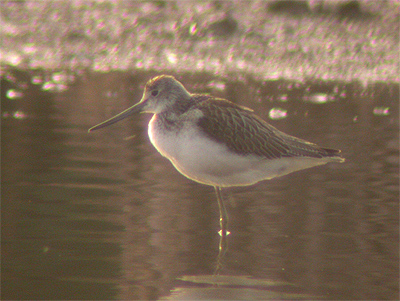 |
|
| .... | ||
| Green Sandpiper Tringa ochropus |
| Was for several years the commonest wader at Eakring Flash, but has become considerably rarer since 2003. The lack of any shoreline has undoubtedly led to this decline. 2007 was the only year which failed to produce any Green Sandpiper records. Eakring Flash held one (occasionally two) over-wintering birds in early 1998, and there were only two other Winter records subsequently, in 2000 and 2002. |
| Wood Sandpiper Tringa glareola |
| Two records. One was at Eakring Flash briefly on August 31st 2001, followed by an extremely confiding juvenile which remained at Eakring Flash from August 6-11th 2003. |
| Common Sandpiper Actitis hypoleucos |
| Rare at Eakring, with Common Sandpiper by no means annual, with a total of eight records. All have come during either April or August and the highest count was of three on August 18th 2003. |
| Turnstone Arenaria interpres |
| There were two (unexpected) records, both in 2000 and involving fly-over records. Two flew north over Eakring Flash on a gloomy May 5th and one flew north-west over Eakring Flash on August 5th 2000. |
| Arctic Skua Stercorarius
parasiticus |
| A dark-phase juvenile flew north-east over Eakring Flash on August 18th 2003. | ||
| Little Gull Larus minutus |
| One record of a group of nine moving north-east over Eakring Flash on April 20th 2003, coming during a period of anticyclonic weather, overcast with north-easterly winds. |
| Black-headed Gull Larus ridibundus |
Although an extremely common species here, large numbers are very rare and I could find reference to just four three-figure counts since 1998. Many of the area's records typically involve small groups or less. A north or north-easterly passage is often noted during late February through to April, with odd birds appearing during May and occasionally June, but it is often during August that records increase in regularity. Many Autumn records involve birds moving west or south-west. The only large counts include:- 388 arriving from the east on July 23rd 2000; 500 Jan 1st 2001; 61 Mar 5th 2005; 119 west Feb 19th 2007. |
| Common
Gull Larus
canus |
Common Gull numbers generally peaked here in November, but there were occasionally good counts early in the year. Groups regularly fed over winter cereal fields, particularly if the weather has been wet. Common Gull counts of over 30 are significant counts at Eakring. There have been just two records from late April-early July which are a 2cy on June 3rd 2000 and an adult on April 23rd 2005. The most notable influx was of 46 on the extremely early date of July 23rd 2000, coinciding with a period of overcast weather, north-easterly winds and a large influx of Black-headed Gulls. The highest count was of 122 on December 8th 2007, including one group alone of 67 at Eakring Flash. |
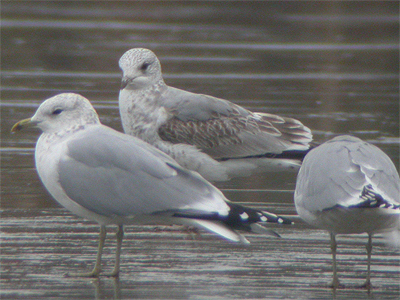 |
|
| .... | ||
Other notable counts include:- 36 on January 23rd and 31 on Nov 7th 2000; An influx during the third week of January with counts of 50+ on both 21st and 23rd, with 83 on 22nd and 74 on 28th and 76 present on Feb 11th 2003; A very high count of 97 at Leyfields, with many birds coming in from the south on March 21st 2006; Good site counts of 49 at Leyfields/Eakring Flash on November 16th and 62 on November 17th, before 75 at Eakring Flash and Church Hill on November 25th 2007. |
||
| Lesser
Black-backed Gull Larus fuscus graellsii |
The commonest of the larger gulls. Lesser Black-backed Gull numbers reach a pronounced peak between early July and late October. A high northerly movement was often noted during the Spring (March-May) but only small numbers were recorded during this time. A record count of 828 Lesser Black-backed Gulls was made in fields at Eakring Field Farm on September 8th 2007. Other notable counts during the last ten years include the following:- 224 July 25th, followed by 420 on August 31st 2000; A large count of 750+ was made on August 18th 2002; 300-400 on August 20th 2003; Two good counts of 250+ on August 12th and 300+ on September 9th 2006; 564 on August 5th preceded the area's largest ever count. 350 were noted on both October 4th and 27th 2007. On October 19th 2002 a colour-ringed Lesser Black-backed Gull was present at Tug Bridge Farm. Research showed that it had been rung at South Walney NR in Cumbria in either 1998 or 1999. |
| Herring Gull Larus argentatus |
Throughout the ten year period, there were two distinct arrival periods for Herring Gulls in the area. UK breeders (argenteus) were usually first noted from mid-late September, but occasionally earlier, although records were uncommon enough to be considered notable. Usually an indicator of the arrival of much colder weather in northern areas were Herring Gulls of Scandinavian origin, i.e. the nominate race argentatus, which started to move through from mid-November. This often coincided with an increase in the number of Great Black-backed Gulls moving through. Herring Gulls proved to be rare in large numbers, but it occurred almost daily throughout the Winter. Late-April and May records were unusual. There were just four counts from the area between 1998 and 2007 that actually reach three figures. Notable counts were 126 on November 9th 2000, 136 moving south-west January 1st and 80 at Leyfields on December 6th 2001, 68 west on January 6th and 95 in fields at Eakring Flash on November 21st 2003, 104 on January 22nd 2005, 86 on January 29th 2006 and a record 166 south-west on November 25th 2007. |
| Yellow-legged
Gull Larus
cachinnans michahellis |
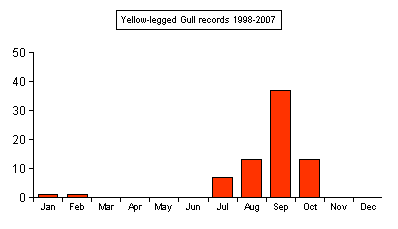 |
Yellow-legged
Gulls proved scarce, but increasingly regular visitors to
the area. The first birds appeared from July, with
records showing a clear peak during the month of
September. The only Winter records are of single 1st
Winter birds in January and February 2001. 2007 represented a particularly good year for Yellow-legged Gulls here, but there seemed no general increase in numbers across Nottinghamshire at the time. Opposingly, there were no records for 2004 and just one record in 2005. A count of six on September 8th 2007, is the highest Yellow-legged Gull count to date. |
|
| .... | .... | .... |
| The full list of Yellow-legged Gull records,
between 1998 and 2007 is shown below. The list is quite
extensive, especially after such a good year like 2007. An adult August 15th, An adult September 3rd, 1998; A 2nd summer south-west July 24th, An adult Eakring Flash July 30th, An adult north-east August 7th, two adults Tug-Bridge Farm, September 5th, Three adults, Eakring Field Farm September 13th, Four adults, Eakring Field Farm September 19th 1999; An adult moving north-east July 16th, An adult moving north-east July 25th, A 3rd Summer moving south-west on September 23rd 2000; A 1st Winter in the Eakring Flash area on January 20th, A 1st Winter at Eakring Flash, February 9th, An adult and a 3rd Winter near Parkhill Plantation September 8-11th, An adult moving south-west October 7th, An adult in fields at Red Hill October 19th 2001; An adult at Church Hill September 4th, An adult September 12-13th, An adult September 18-21st, Two adults at Tug Bridge Farm October 11th, An adult at Eakring Flash October 16th 2002; An adult near Eakring Meadows September 11th, Two adults October 11th, An adult at Eakring Flash October 13-16th 2003; Two (a 2nd Summer and 3rd Summer) in fields near Eakring Flash July 24th 2005; A 3rd Summer near Eakring Flash July 29th, An adult and a 3rd Summer in fields north of Leyfields August 12th, An adult at Eakring Field Farm August 19th, An adult at Park Farm/Eakring Field Farm September 5th 2006; One in fields near Leyfields and Church Hill August 4-5th, Two in fields at Church Hill August 9th, A 2cy near Eakring Flash, August 18th, Three adults at Church Hill August 23rd, A 1cy in fields between Eakring and Kneesall August 25th, Five in the area, including a 1cy, 3cy and three adults at Church Hill and near Eakring Field Farm September 3rd, Three at Church Hill including two adults and a 3cy bird September 5th, Six, including two adult females, two adult males, a 2cy male and a 1cy male at Eakring Field Farm September 8th, Five (two adult females, one adult male, a 1cy female and a 1cy male) at Eakring Field Farm September 9th, An adult near Eakring Field Farm September 17th, An adult female at Church Hill September 26th, A 3cy bird near Leyfields October 4th, An adult at Park Farm October 6th, Two adults at Church Hill October 13th, An adult and a 1cy at Church Hill October 14th 2007. |
||
| Caspian Gull Larus
cachinnans |
| The only record to date, was of an adult in fields north of Red Hill, amongst c400 Lesser Black-backed Gulls on August 20th 2003. |
| Iceland Gull Larus glaucoides |
| There are two records, which probably related to the same bird. An adult flew south-west over Leyfields on December 31st 2000, then again south-west over Eakring Flash on January 1st 2001. |
| Great
Black-backed Gull Larus marinus |
Great Black-backed Gulls are rare in numbers at Eakring. Since 1998, there have been just three counts including 49 on November 9th 2000, 77 moving south-west on January 10th 2004 and 50 moving south-west on November 25th 2007. Influxes seem to coincide with the arrival of argentatus Herring Gulls. There is just one Summer record and the first birds rarely appear before the end of September. An increase in sightings usually comes during early November of most years, but Great Black-backed Gulls are not recorded on a daily basis, even during the depths of Winter. |
| Kittiwake Rissa tridactyla |
| There are three records of Kittiwake. One moved south-east over Red Hill on October 3rd 1998 and remained the area's only record until two in 2007. Two 1st Winter birds moved west on September 27th, followed by an adult moving north-east over Eakring Flash on November 10th 2007. |
| Common Tern Sterna hirundo |
| Recorded annually, but quite rare most years. Late April and early May were typical dates for the first passage birds, but one moving north-west over Eakring Flash on March 24th 2003 represented the earliest ever Common Tern in Nottinghamshire. Return passage was largely noted in July with ten records. August produced three further records but the latest birds to date, were three at Eakring Flash on September 27th 2007. |
| Arctic Tern Sterna paradisaea |
| There were six records including 16 moving north-east over Eakring Flash on May 1st 1998, one moving north-west over Eakring Flash May 8th 2000, seven moving north-east over Eakring Flash on May 15th 2001, nine moving north over Eakring Flash on May 4th and three moving north over Eakring Flash on May 7th 2005, with five moving north over Eakring Flash on April 28th 2006. |
| Feral Rock Dove Columba livia |
| Common. A small population of around 30 birds, was present around Eakring village for several years in the late 1990's and early 2000's. By 2007, regular counts were considerably smaller. |
| Stock Dove Columba oenas |
| A relatively small population has bred in the area each year. Any single flock count of over 20 birds is very rare here, but an exceptional 279 Stock Dove were in the Eakring Field Farm and Tug Bridge Farm area on October 26th 2002. Was occasionally recorded in very small numbers, moving south or south-west with flocks of Wood Pigeon during the Autumn, the best count of which was 18 moving south-west on November 3rd 2001. |
| Wood Pigeon Columba palumbus |
| Very common. During the
Winter months, numbers in the area often varied
considerably. There have been several instances of Wood
Pigeon flocks containing well over 1 000 birds, but the
highest ever daily count was when a minimum of 7.000 were seen leaving several roost
sites in the area on December 8th 2007. Over 31 500 Wood Pigeon have been counted during Autumn movements, with seasonal totals being much higher from 1998-2001. Largest movements have coincided with the first real frosts in late October and early November and always during fine weather. In 1998, a total of 10 564 Wood Pigeon moved south over a three day period on October 29-30th and November 1st. A completely white bird was present at Eakring Flash on December 15th 2007. |
| Collared Dove Streptopelia decaocta |
| Common with both Eakring and Kersall villages holding very healthy breeding populations. Birds are occasionally noted on passage during the Autumn. |
| Turtle Dove Streptopelia turtur |
||||||||||||||||||||
| Arrival dates 1998-2007 | ||||||||||||||||||||
|
||||||||||||||||||||
| Since 1998, there has
been a decline in the numbers of breeding pairs at
Eakring and Kersall. A maximum of four pairs were found
in 1998, but this has dropped to just a single breeding
pair since 2006 after a gradual decline during the
intervening years. Suitable and unoccupied breeding
habitat is severely limited here, but still available.
During the past ten years, just three sites have seen
pairs breed successfully with unpaired males holding
territory for short periods of time at a further three. The Oil Bore Holes site, on the western-edge of Eakring village is the only one of these to have been used consistently since 1998, with a second pair here breeding from 1998-2002. A pair nested at High Trees (on the eastern-edge of Eakring) from 1998-2003 and although a male was present there in 2004, there was no evidence of breeding and it has remained unused since. A site at Kersall held successful breeding in 2004 and 2005, but they failed to return the following year. In recent years, possible breeders have frequented an area on the western side of Red Hill in 2005, the pastures area between Eakring village and Eakring Flash since 2006 and at Tug Bridge Farm in 2007. A pair with two young were present at this site on one August 2007 date, but were believed not to have been locally bred and there was certainly no supporting evidence of this. |
||||||||||||||||||||
| .... |
| A decline in the numbers
of breeding birds, has largely been reflected in the
number of Turtle Doves recorded on passage since 1998. Both periods of migration are distinctly different. Spring migrants have generally moved through the area between April 29th and May 25th. There are a few exceptions to these dates, with an extremely early bird through on April 18th 2000 (one of the earliest ever Turtle Dove in Nottinghamshire) and there are odd migrants occasionally noted within the first week of June. 1999 was an excellent year for migrant Turtle Doves during both migration periods, although there were still only three breeding pairs in the area. |
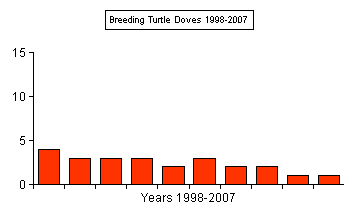 |
|
| .... | .... | .... |
| Like other
migrants, this species is often affected by poor weather
over the near continent during the Spring - hence there
were just three Spring migrants in 2000 and 2002. 2007
was another very poor year, yet the weather was much
better for migration and Turtle Doves arrived back at
Eakring quite late on May 5th. The latest ever arrival
was on May 11th 2006. Migrant figures produced in the
Spring, have dropped markedly on the whole since 1998,
matching the area's breeding pair counts. A rare build-up of 22 Turtle Dove at Eakring Field Farm on September 2nd 2003, remains the highest ever count here. |
||
| Cuckoo Cuculus canorus |
||||||||||||||||||||||||||||
| Arrival dates 1998-2007 | ||||||||||||||||||||||||||||
|
||||||||||||||||||||||||||||
| Formerly a regular
breeding bird, but has become considerably rarer here.
The earliest arrival date was April 19th 2000. There were
just two Autumn records of a juvenile south-west on July
23rd 2000 and one briefly at Eakring Flash on August 16th
2003. It was in 2003 when the number of Cuckoo records here first dropped. At first I thought that this may just simply be down to it being a poor year, but worse followed a year later, when there were slightly fewer records. The general decline in the number of Cuckoos across the UK is now well known and accepted. There is no physical reason to explain this decline, but it possibly corresponds to a decline in one or more of the Cuckoo's host species. |
||||||||||||||||||||||||||||
|
||||||||||||||||||||||||||||
| The above table charts
the arrival dates of (possibly) the same two returning
male Cuckoos that held territories in the area for
several years, although it must be borne in mind that
this cannot be confirmed, but they were observed to use
the same trees each year for calling, although not
habitually and on a daily basis like some species do. The
birds held large territories centred around Eakring
village from 1998-2003 and in the Eakring Meadows/Kersall
village area from 1998-2002. If these records do indeed
relate to the same males, then they both showed
remarkable punctuality in their arrival dates. For the
Eakring bird, these ranged between April 20th and April
26th over a six year period. For the Eakring Meadows
bird, aside from the mid-May arrival date in 1999,
arrival dates were between April 29th and May 1st. What
was also noticeable, was that the Eakring Meadows male
consistantly arrived seven-ten days later than the
Eakring male. The table below lists all the records of Cuckoo I have from the area between the years 1998 and 2007. It is clear to see how the general number of records has dropped since 2001 and that there has been no long-staying male in territory here now since 2003. Apparently there are very few adult Cuckoos ringed and even fewer recoveries. |
||||||||||||||||||||||||||||
| Year | Records/individuals .........Abbreviations used: ...M = male ... F = female ... U = unsexed or non calling passage bird | |||
| ... | ... | ... | ... | ... |
| 1998 | (M) April 22-May 24th Eakring village/Eakring Flash/Red Hill; (M) April 29-May 24th Eakring Meadows Nature Reserve/Kersall; (M) May 4th Leyfields; (F) May 10th Red Hill; (F) May 19th Kersall | |||
| 1999 | (M) April 26-June 10th Eakring Flash/Red Hill; (M) May 5-June 10th Lound Wood/Eakring Flash; (M) May 7-25th Eakring village; (F) May 11-15th Eakring village; (M) May 15-June 12th Eakring Meadows Nature Reserve/Parkhill Plantation | |||
| 2000 | (M) April 23-June 18th Eakring village/Eakring Flash; (M) April 30-June 4th Kersall; (M) June 4th Eakring Field Farm; (F) June 18th Eakring Flash | |||
| 2001 | (M) April 24-May 18th Eakring village/Eakring Flash/Church Hill; (F) April 29th Eakring village/Eakring Flash; (M) April 30th Eakring Meadows Nature Reserve; (F) April 30-May 4th Eakring Meadows Nature Reserve; (M) May 13th Eakring Flash; (F) May 18th Church Hill | |||
| 2002 | (M) April 20-June 2nd Eakring Flash/Eakring village/Red Hill; (M) May 1-16th Eakring Meadows/Kersall; (F) May 15th Eakring Flash | |||
| 2003 | (M) April 22-May 24th Eakring village/Eakring Flash; (M) May 8-12th Kersall; (F) May 2nd Eakring Flash | |||
| 2004 | (M) April 26-27th Eakring village/Eakring Flash; (M) May 16-20th Eakring Flash/Eakring village | |||
| 2005 | (F) April 28th moving east, Eakring Meadows; (U) April 30th moving north-east, Eakring Flash; (M) May 3-8th Red Hill; (U) June 26th moving east, Red Hill | |||
| 2006 | (F) May 4th Eakring Meadows; (U) June 17th moving north, Eakring Flash | |||
| 2007 | (U) May 3rd moving north, Eakring Flash | |||
| Some of the above records
possibly relate to the same two returning males, both of
which held large territories centred around Eakring
village/Eakring Flash from 1998-2003 and around Eakring
Meadows/Kersall from 1998-2002. The actual number of
different males calling from any individual site within
the area, was always checked to confirm the number of
birds actually present as it was easy to assume that just
one bird was responsible. Since the presumed demise of
these two males, territories since have always been held
by males for a much shorter time corresponding with a
drop in the number of males recorded. Likewise, the number of females recorded has also dropped in recent years. Since 2005 all but one Cuckoo here has been brief. The male recorded in the Red Hill area three times between May 3rd and 8th, spent most of it's time well outside the recording area. |
| Barn
Owl Tyto
alba |
|||
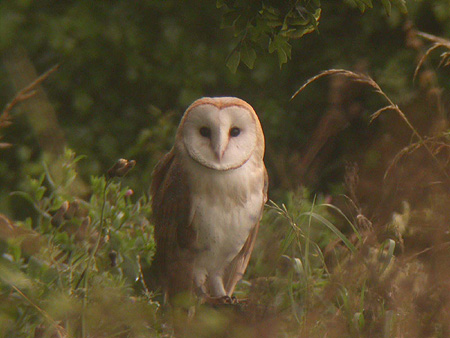 |
For the most part, Barn
Owl has always been very rare here, but a pair bred
successfully in 2005, for the first time in more than a
decade. One of the adults was rung at Laxton in 2004 by
the North Notts Ringing Group and this pair have since
gone on to breed annually using an artificial nest box.
The implementation of set-aside strips has helped these
birds considerably, by creating large areas of suitable
grassland habit. Between 2000 and 2005, I personally recorded Barn Owl on just three occasions, but there were occasional reports of hunting birds from local residents. In late 2007, Barn Owls had been recorded from Eakring Flash, Lound Wood and Red Hill area. All these sightings were believed to refer to dispersing young birds. |
|
| .... | ||
| Little Owl Athene noctua |
| For much of the past decade there were at least three/four pairs in the area at any one time. Regular breeding took place at sites near Eakring Field Farm, along the Kneesall Road, near Kersall and at Red Hill, but regular birds have also come and gone at several other sites over the years. The Kneesall Road pair were last seen in 2005, whilst the Red Hill and Eakring Field Farm pairs both relocated to new nest sites in 2001 and 2007 respectively. There have been several road casualties. |
| Tawny Owl Strix aluco |
| Fairly common. A maximum of seven pairs occupied territories in 1998 and recent pair counts suggests that the population has remained fairly static. |
| Long-eared Owl Asio otus |
| Not recorded until 2001, when a bird was seen in the pastures/Eakring Flash and Red Hill areas from July 12-14th 2001 and then again from June 17-July 5th 2002. In 2005 one was noted several times hunting the Eakring Flash and Red Hill areas and was observed taking food back to the nest. One/two birds were present in a roost near Kersall early in 2007 and breeding was later confirmed at this site, when adults were observed taking food back to the nest site. Two were also in a roost in the Red Hill area on July 20th 2007. It is likely that one or two pairs have bred annually since 2001. |
| Short-eared Owl Asio flammeus |
| Rare here. Just six records between 1998 and 2007 include, a single moving high north-west over Leyfields/Lound Wood on November 13th 1999, one near Red Hill/Eakring Flash on December 27th 2000, one at Penny Pasture Common, Eakring Meadows on September 18th 2003, one in the Eakring Flash area on April 10th, one over Red Hill, gained height and flew off east on May 1st 2005 and one at Eakring Flash on May 7th 2006. |
| Swift Apus apus |
||||||||||||||||||||
| Arrival dates 1998-2007 | ||||||||||||||||||||
|
||||||||||||||||||||
| Becoming increasingly
scarce in recent years. The number of breeding Swift at
both Eakring and Kersall villages has always been low.
Eight pairs were counted in 1998 and this total dropped
to just six in 2007. Earliest and latest dates are April
21st 2007 and September 29th 2001 respectively. There were very few large movements of Swifts recorded. 737 moving west on June 24th 2000, remained the only notable count until an estimated 700 Swift were feeding over fields around Eakring Flash on June 29th 2005. The same year also went on to produce counts of 508 south-west during the mid/late afternoon of July 25th, then 1 270 north-west on July 30th. An estimated 2 000+ Swifts feeding on insects over recently harvested fields in the Eakring Flash and surrounding area on August 1st 2005, was by far the highest count, with 500 present on August 4th 2005. |
||||||||||||||||||||
| Kingfisher Alcedo atthis |
| Recorded infrequently over the years, with Eakring Flash providing the bulk of records during late Summer and early Autumn. |
| Green Woodpecker Picus viridis |
| Remained quite scarce for several years until an increase in records from 2002. Although regularly recorded from the Lound Wood and Red Hill areas since 2003, there has been no record of successful breeding. |
| Great Spotted
Woodpecker Dendrocopos
major |
| Recorded almost daily. Pairs have bred annually at Lound Wood and Hare Hill Wood. |
| Lesser Spotted
Woodpecker Dendrocopos
minor |
| Very rare here with just four records and not seen here since 2004. Two at Lound Wood on November 27th 1997, singles at Tug Bridge Farm on January 5th and Eakring Flash on December 11th 2003 and one near Eakring Flash on February 21st 2004, are the only records. |
| Wood Lark Lullula arborea |
||||||||||||||||||||
| Arrival dates 1998-2007 | ||||||||||||||||||||
|
||||||||||||||||||||
| Rare here and only recorded on passage. All six Wood Lark records came between September 16- October 26th. One flew south-east on October 7th and one flew south-west over Tug Bridge Farm on October 11th 2001, four flew low south over Eakring Flash on September 30th 2002 and one was in fields adjacent to Eakring Flash on October 26th 2003. There was then a two year wait before the next Wood Lark, when one flew north-west on September 30th 2006 and four flew north-east over Eakring Meadows on September 16th 2007. | ||||||||||||||||||||
| Sky Lark Alauda arvensis |
| Since 1998 the Sky Lark
has done extremely well since the initial breeding bird
surveys were carried out in 1998. Survey findings over
the next seven years showed Sky Larks increased from just
ten breeding pairs in 1998, to a maximum of 39 pairs in
2005. This equated to an average of 4.875 pairs per
square km if the area's population was evenly spread
across the area. Yet despite it's great increase, there
are still large sections of the recording area, which
fail to support any breeding birds. In 1998, breeding Sky Larks were found chiefly to the west of Eakring Flash, in the Church Hill area, with single pairs at Eakring Field Farm and Park Farm. During the intervening period until the 2005 survey, nesting Sky Larks continued to spread out in all directions from the original survey plots. The spread continued east of Eakring, roughly following the southern boundary of the recording area at Church Hill and through to Eakring Field Farm. Land south of Kersall has remained sparsely populated, despite permanent set-aside being created several years ago. Sky Lark used to be recorded in good numbers during Autumn migration, but numbers have been considerably less since 2003. The biggest movements came in late December 2000. Small amounts of snow in the Eakring and Kersall area on December 28th, was bettered by much heavier snowfalls (coupled with sub-zero temperatures) in the north-east of the country. This meant a departure by some species away from such conditions and Sky Lark was one of the dominant species involved. Movements of all species took place over a four day period, but Sky Larks were only recorded moving on both the first and second days only, with a highest count of 607 south on December 29th the largest part of a 675 total. Very few birds have been noted moving north in the Spring. Large over-wintering groups have been rare, but there were counts of 50+ Skylark in a stubble field at Eakring Field Farm on January 2nd 2004 and 45 in set-aside at Eakring Flash on November 18th 2006. A Sky Lark population count on November 28th 2004, saw a minimum count of 83 birds present at three sites. |
| Sand Martin Riparia riparia |
||||||||||||||||||||
| Arrival dates 1998-2007 | ||||||||||||||||||||
|
||||||||||||||||||||
| Recorded only as a
passage migrant at Eakring. Numbers on migration have not
been extremely high, but bearing in mind the small water
area of Eakring Flash, large Sand Martin counts are
probably indicative of broad front movements across the
county. 1999, 2000, 2002 and 2004 all produced good accumulative totals. In Spring, the highest single day counts included 60 moving north-east on March 27th 2000, 39 moving north April 25th 2000 and 43 moving north and north-east May 16th 2001. The first returning Sand Martin are often noted during the last week of June and in some years there is a distinctive passage around this time. A group of 23 Sand Martin flying west over Lound Wood at dusk on June 17th 2003, were difficult to categorise. The best of the Autumn movements were 53 south on July 17th and 32 south-east on August 26th 2000, 32 moving south on June 29th 2002, but a record 103 went south through Eakring Flash on July 28th 2005. |
||||||||||||||||||||
| Swallow Hirundo rustica |
||||||||||||||||||||
| Arrival dates 1998-2007 | ||||||||||||||||||||
|
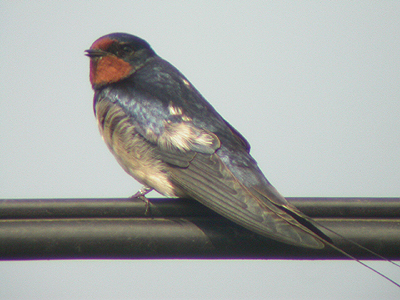 |
As a breeding bird, the
Swallow is one of few species to have shown a decline
since 1998, with loss of nesting habitat being the
biggest cause here, as farm buildings are converted.
Pairs still breed at all farms in the area and at both
villages, but it is within the confines of Eakring
village that some pairs have been lost to such
developments. The greatest numbers of Swallow have always been recorded on migration, most especially during the Autumn. 1999 and 2000 both saw accumulative counts of over 3 000 Swallows, but counts since 2003 have all been much lower. 541 south on September 18th 2002 and 613 south on September 28th 1999 were some of the best visible migration counts reached, but these were surpassed by an even larger movement in September 2000. |
|
| .... | .... | .... |
| On September
24th 2000, 1 167 Swallows moved south-west. This was a
most unusual day's migration, with several long periods
during which noticeable movements by any species remained
non-exsistent. Conditions were overcast, but visibility
was good and the first Swallows didn't appear until after
9:00am. Soon after, groups of Swallows began continuously
passing through the area and totals quickly rose past the
500 mark, an hour after the first Swallows were recorded.
At this point, all movement stopped as suddenly as it had
started until a further hour later, when a second wave of
birds moved through, taking the morning's total to a
record 1 167 Swallows. This second wave again lasted for
only an hour and was as intense as that of the first
period. A most unusual record was the pure white Swallow, which flew south-east over Eakring Meadows on September 25th 2002. |
||
| House Martin Delichon urbica |
||||||||||||||||||||
| Arrival dates 1998-2007 | ||||||||||||||||||||
|
||||||||||||||||||||
| 16 pairs of House Martin
bred in the area during 1998, this dropped to 12 pairs in
2000. There is still a fairly low breeding population at
Eakring and Kersall villages, with birds also breeding at
Tug Bridge Farm, Eakring Field Farm and Leyfields. During the Autumn, pre-migratory counts have reached 200 birds including many juveniles. The best of the visible migration counts were 833 south on September 25th 1999, 590 south on September 23rd 2000 and 665 south on September 21st 2001. There were no similar counts for the rest of the period. April 3rd 2004 was a very early arrival date. |
||||||||||||||||||||
| Richard's Pipit Anthus richardi |
| One flushed at Kersall/Hare Hill Wood on September 20th 1998, flew low south-west towards Eakring Meadows, but was never relocated. |
| Tree Pipit Anthus trivialis |
||||||||||||||||||||
| Tree Pipit arrival dates 1998-2007 | ||||||||||||||||||||
|
||||||||||||||||||||
| An uncommon passage migrant, although the total of 45 records involving 69 birds might suggest otherwise. There have been just 11 Spring records since 1998 and both 2004 and 2005 represented extremely poor years with just single records. Migrants have been rare after mid-September, but there were a series of late records in 2000, when two moved south and south-east on September 27th, two moved south-west on September 28th and two more moved south and south-west on October 1st. These late records coincided with large movements of Meadow Pipits and other species. Seven moving south on August 15th 1998 and six (one moving north and five south) on August 20th 2000 were the highest counts. | ||||||||||||||||||||
| Meadow Pipit Anthus pratensis |
| Only recorded as a
passage migrant in both Spring and Autumn. Small numbers
of Meadow Pipits have sometimes over-wintered in the
area, but 50+ in fields near Parkhill Plantation on
December 16th 2006 was exceptional. There have been no
records of males holding territory during the Summer
months, although odd males have occasionally set up
territories for a short while during May. Daily passage of Spring migrants usually began in mid-March, but odd singles were noted from as early as mid-February. Peak dates for were recorded from March 21-31st, very rarely any later than this and birds continued to move throughout April and into early May. Good numbers of passage Meadow Pipit were never recorded annually during the Spring. 2001 provided the only exceptional Spring counts. Previous observations had never before revealed such a profile of their migration as that attained in 2001. Record three figure counts occurred with 267 north-west March 15th and 239 north-west on March 24th. Counts of over 70 birds were also recorded on a further three dates. |
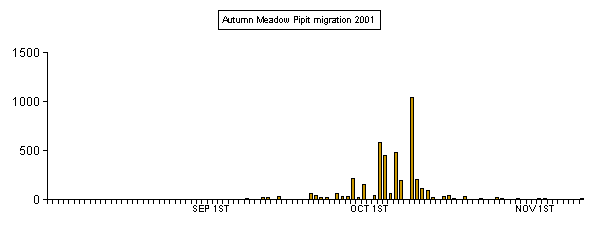 |
The Spring 2001 total of
1 433 birds, meant that it was nearly double that of
Spring 1998 and the Autumn went on to be even better. 4 021 Meadow Pipit moved through Eakring and the whole Autumn period was very unusual for the frequency of three-figure counts. All these combined to produce the migration profile depicted in the graph. |
| .... | .... | .... |
| From
September 28-October 11th, there were four counts over
400 and a peak count of 1 045 Meadow Pipits. These counts
included 213 south and south-east on September 28th, 155
south and south-east on September 30th, 585 south and
south-east on October 3rd, 450 south and south-east on
October 4th, 481 south and south-east on October 6th, 194
south on October 7th, 1 045 south and south-east on
October 9th, 201 south on October 10th and 109 south on
October 11th 2001. The whole movement also coincided with
good numbers of finches and wagtails. In 2000 it was a similar situation but the counts were considerably less. The largest movements occurred on most days when conditions were favourable and to some extent, when such counts seemed most unlikely. The two peak dates were September 27th and 29th (both days producing counts of 500+) Other notable dates included 209 south on September 17th, 109 south on September 24th, 152 south and south-east on September 25th, 152 south on September 28th, 210 south on September 30th and 327 south on October 1st. Since 2003, total yearly counts have been low, even when the weather conditions were favourable for large Meadow Pipit movements. |
||
| Rock Pipit Anthus petrosus petrosus |
| There were four records, all during the Autumn. Singles flew west over Eakring Flash on October 4th 1998, October 17th 1999, October 9th 2000 and October 21st 2007. |
| Yellow Wagtail Motacilla flava flavissima |
||||||||||||||||||||
| Arrival dates 1998-2007 | ||||||||||||||||||||
|
| Recorded largely as a
passage migrant. The number of breeding pairs has always
remained low and the most regularly used sites were at
Eakring Flash and Eakring Field Farm, with a pair
breeding once at Church Hill. Spring passage has produced monthly maxima of 41 (April 1998) 35 (April 1999) and 33 in both 2000 and 2006. Counts were always lower during May with a maximum of 31 in May 2001. 2000 produced record numbers of Yellow Wagtail. The total for both periods of passage was 181, which remains well above any other annual count before or after 2000. Migrants were noted from July 5-September 28th 2000, with peaks of 23 moving south on September 10th and 16 moving south on September 17th. Both of these represented late dates for peak counts, which typically have occurred around mid-late August. |
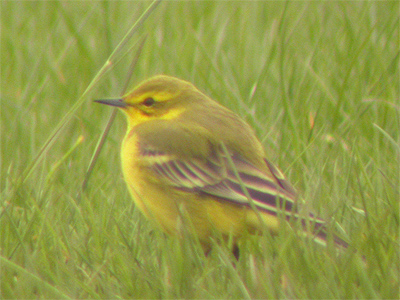 |
|
| .... | .... | .... |
| In August 2007, very few passerines were noted on visible migration watches during anticyclonic weather. Varying numbers of Yellow Wagtails were present on flooded pasture at Tug Bridge Farm, showing that many species were obviously still passing through, but that most were obviously at high altitude. An extremely good count of 18 were present on August 27th, but most days produced counts well into double figures. Among these was a juvenile which was fitted with a metal BTO ring and present on August 26th. Early September produced 17 on September 3rd. Monthly totals of 65 Yellow Wagtail moved through during August, with another 45 in September, making this the best year since 2002. | ||
| Grey Wagtail Motacilla cinerea |
| Only ever recorded as a passage migrant, with highest numbers recorded during late September and early October, usually of singles moving high south. A few birds have over-wintered, mainly around Eakring STW and occasionally being seen at Penny Pasture Common. There were no records of males holding territory. Yearly migrant totals included 29 and 33 in 2001 and 2002 respectively. Six moving south on September 30th 2001 and five moving south on October 13th 2002, represent the highest daily counts. |
| Pied Wagtail Motacilla alba yarrelli |
||||||||||||||||||||
| Regularly recorded on passage and with a surprisingly small breeding population of six and eight pairs. Total visible migration counts have shown considerable variation, ranging from 446 birds in 2000, to just 56 in 2007 and with a highest single day count of 76 moving south on September 29th 2000. Migrant numbers have generally peaked during the second half of March and the first half of October. | ||||||||||||||||||||
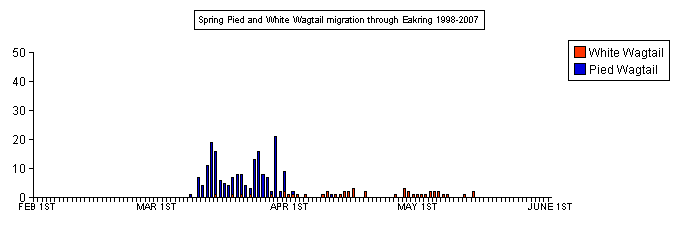 |
||||||||||||||||||||
| From 2005, local wintering Pied Wagtails have occasionally used a small roost at Eakring Flash. 37 Pied Wagtail were observed coming into the roost on February 12th 2006. A peak count of 62 roosted on October 16th 2007, but this may have been largely made up of migrants as the roost was short-lived. By November 2nd, the roost had been reduced to just 17 birds and counts decreased even further after this date. | ||||||||||||||||||||
| White
Wagtail Motacilla alba |
||||||||||||||||||||
| Arrival dates 1998-2007 | ||||||||||||||||||||
|
||||||||||||||||||||
| An uncommon passage
migrant, mostly during the Spring and with just one
Autumn record. White Wagtail occurrences have been within
three distinct periods, with most records coming during
mid-April and late April/early May. The earliest date was
on March 19th 2002. This was a relatively early
individual, with the last week of March usually producing
the first records. Interestingly this more or less
coincides with the end of the Pied Wagtail's Spring
migration period. Pied Wagtail produces a relatively
short period of migration, almost totally confined to two
weeks in late March, with just three April records since
1998. Although the calls of each are similar, White
Wagtail's is generally quieter and more subdued than the
Pied Wagtail. It is quite distinct when compared to
grounded individuals, but cannot be relied upon for
identification of overhead passage birds for obvious
reasons, so it is possible that many White Wagtail are
missed among fly-over Pied Wagtail. The full list of records involve singles on March 31-April 2nd, April 13-14th, April 15-16th, April 28-May 8th and May 14th 1998; April 26th, April 28th, May 4-6th and May 14th 1999; March 27th, April 14-15th and April 19th 2000; April 9-10th, April 10th, April 12th and May 12th 2001; March 19th, April 28-29th and May 3rd 2002; March 15th, March 23rd and April 5th 2003; March 21st; and April 3rd 2004; April 16th 2006; March 31st and April 18th 2007. There is just one Autumn record, that of three with Pied Wagtails in fields adjacent to Eakring Flash on October 5th 2000 and coming just after the rather early Pied Wagtail migratory peak of that year. White Wagtails have shown more of a tendency to remain on-site for up to several days, quite an unusual feature among most Spring migrants here. Many males are often persistently harassed by male Pied Wagtails which hold territory in nearby Eakring village. Such harassment has not been noted among Pied Wagtail males (even without male White Wagtail present) |
||||||||||||||||||||
| Waxwing Bombycilla garrulus |
| Just two records of 11 moving east over Eakring Meadows on March 29th 2003 and a single north over Eakring Flash on March 25th 2007. |
| Wren Troglodytes troglodytes |
| Common. The 1998 breeding bird survey found a total of 38 pairs in the area, but this rose dramatically to 75 pairs in 2000. Such a high number was checked and although there was a definite increase, it was thought that there had also been a considerable undercount in the 1998 survey. |
| Dunnock Prunella modularis |
| Common. Birds were often noted moving off high south-west during September. In 1998, the breeding bird survey found that the area held 28 pairs, with roadside hedges being particularly favoured. |
| Robin Erithacus rubecula |
| There was a breeding population of approximately 63 pairs in 2000. During September and October, numbers were often increased by the arrival of short-staying migrants. |
| Redstart Phoenicurus phoenicurus |
||||||||||||||||||||
| Arrival dates 1998-2007 | ||||||||||||||||||||
|
| An uncommon passage migrant. Redstart produced just eight Spring records, with seven in April and just one in May. There were two records in both Spring 2001 and 2004, one in 2005 and finally three in 2007. | ||
| .... | .... | .... |
 |
Inclusive dates for
Spring migrants were April 11-May 1st. Autumn limits
ranged from July 9th-October 11th. Two birds in July were
found to be very early. The majority of the area's 43 Redstart records came during the Autumn, particularly from August-September, but there are several October records, including some from long-staying birds which had arrived in late September. The most notable of these was a 1st Winter male with an injured leg, which remained at Penny Pasture Common for 25 days. It left on October 10th, the day before the area's latest ever date of October 11th, set by another long-staying 1st Winter male. With the possible exception of Bennerley Marsh, a total of 35 Autumn records probably now make this the most productive area in the county for migrant Redstarts. |
|
| .... | .... | .... |
| Prior to 1998, there are no available records from the area. Most records (both Spring and Autumn) have come from Hawthorn scrub or along hedgerows, and all but two have occurred from the three main sites for the species - Eakring Meadows, Eakring Flash and Red Hill. The scattered Hawthorns on Penny Pasture Common (one section of the Eakring Meadows NR) are particularly favoured by Autumn migrants, having provided most of the records from the past few years. | ||
| Whinchat Saxicola rubetra |
||||||||||||||||||||
| Arrival dates 1998-2007 | ||||||||||||||||||||
|
||||||||||||||||||||
| An uncommon passage
migrant with 110 individuals noted between 1998 and 2007,
with a large fall in the number of records since 2003.
The lack of Whinchat records in recent years has been
particularly evident in the Autumn. Whinchats have shown
a distinct preference for Penny Pasture Common and
Eakring Flash, although the latter site has failed to
produce any records since 2006. An increase in the amount
of Sallow is thought to be the cause and birds at Eakring
Flash, are now predominantly attracted to Broad Bean and
Sugar-beet crops growing adjacent to the flash. There
were few records from other sites away from Eakring Flash
and Penny Pasture Common. Most of these involved hedgerow
birds at Tug Bridge Farm. One very unusual record came in
Spring 2002, when a bird frequented an Ivy-covered tree
near Kersall. Whinchats have certainly shown an association with Wheatears on migration. Evidence of this coming from the numerous times, both have shared the same feeding site/field, also arriving simultaneously like most members of this group about two hours after first light. There were few records of birds arriving after mid-day, but it did occur on a few occasions. Spring migrants showed two quite restricted periods of arrival, from April 22-27th and May 11-14th. As expected, Autumn limits produced the greatest variation in dates, being recorded from July 21-October 1st, with a general peak coming between August 28-September 14th. Good numbers arrived during early September 1998, when various groups included up to six at Penny Pasture Common on September 3-4th. A clear peak in the number of arrivals has since been shown to occur around this time, with no records before the middle of August prior to 2004 when the first returning migrant arrived at Eakring Flash in July. |
||||||||||||||||||||
| Stonechat Saxicola torquata |
||||||||||||||||||||
| Arrival dates 1998-2007 | ||||||||||||||||||||
|
||||||||||||||||||||
| Stonechats first appeared
here in October 1999 but then become more or less annual
visitors to the area, producing records of 26 birds in
both early Spring and Autumn. During October 2001, there
was a good Stonechat influx nationally and this was also
reflected here around October 10-12th when there were
five records, including four on October 11th. There was
another small influx in October 2007 and most birds were
typically brief, staying for either one or two days. Eakring Flash and Penny Pasture Common have provided the bulk of the records, but birds have also been found perched on roadside hedgerows in the Red Hill, Tug Bridge Farm and Church Hill areas. Autumn Stonechat records had been concentrated to within a ten-day period in October until the occurence of the area's earliest ever arrival on September 20th 2002. Spring migrant dates ranged from February 21-March 26th with five records occurring on March 11-12th, with Autumn migrants appearing being from September 20-October 20th. There is just one Winter record on December 30th 2000 and occurring during a period of cold weather. |
||||||||||||||||||||
| Wheatear Oenanthe oenanthe oenanthe |
||||||||||||||||||||
| Arrival dates 1998-2007 | ||||||||||||||||||||
|
||||||||||||||||||||
| A regular passage migrant
here, with 144 birds recorded. The earliest Spring
arrival is March 22nd 2000, but there were no further
March records after 2003. Over the ten year study period,
Wheatears typically arrived within the periods March
22-28th and then again in the second half of April. There
were variations and bad weather certainly contributed to
rather late arrival dates some years. The largest numbers occurred during the Spring. A large arrival occurred on the April 22nd 2000, during a morning of heavy rain. Seven birds were present in the area, following an arrival during the morning. A male and female were on Red Hill, three females at Tug Bridge Farm and a single female briefly at Eakring Flash. Most arrived from mid-morning onwards. By the afternoon, several birds present during the morning, had presumably moved on. Four females at Tug Bridge Farm, being joined by another in the afternoon. In addition, a further three new birds arrived the next day, bringing the total for the month to 13 birds. |
 |
| Another distinctive
arrival took place on April 16th-17th 2004. This time
anticyclonic weather allowed good numbers of migrants to
arrive on the back of light southerly winds. The large
arrival of migrants which occurred also included
Wheatear, with a minimum of eight birds on these two
dates. The most favoured site was the horse paddocks on
the outskirts of Eakring village, but traditional areas
like Church Hill and both Tug Bridge Farm and Eakring
Field Farm again produced records. April 2006 provided the best ever Spring counts, with 30 Wheatears (including three Greenland birds) recorded from April 9-29th. Remarkably these were the only records for the whole of that year. Typically, the majority of records came from bare fields at Tug Bridge Farm and Church Hill, with few sightings coming away from these sites. The first was a female in fields at Stonish Hill near Eakring village on 9th, followed by a male at Tug Bridge Farm and a female at Church Hill (both on 15th) the day that marked the start of daily passage that continued until April 27th. Between April 16th and 23rd, the total number of birds in the area never fell lower than four and the highest count of eight was on April 22nd and 23rd. Autumn records came from August 15-October 13th, with most confined to September. October birds were unusual and included two at Eakring Flash on October 4th and one at Red Hill on October 13th 1998, one at Tug Bridge Farm on October 1st 2000 and one at Eakring Flash on October 9th 2001. |
| Greenland Wheatear Oenanthe
oenanthe leuchorhoa |
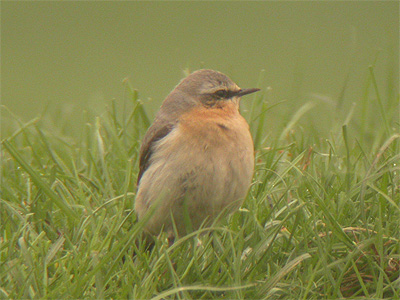 |
A total of 19 birds of
the leuchorhoa race were identified, but the
actual number was probably more. Spring saw two notable
periods of arrival. Heavy early morning rain on April 30th 2005 saw three Greenland Wheatear grounded at Eakring Flash, coinciding with large numbers of Wheatears, including many Greenland birds at Spurn Point in Yorkshire the same day. April 2006 produced three records with a pair at Eakring Meadows 17-19th, with the male male remaining till April 20th. Another male was present at Tug Bridge Farm for two days on 26th and 27th and the size of this bird made it very easy to pick out from birds of the nominate race it was with. Six Autumn records of Greenland Wheatear have provided inclusive dates of September 19-October 17th. The full list of records is produced below. |
|
| .... | .... | .... |
| A female at Eakring Flash on May 9th 1998, a female near Church Hill on May 20th and two female/immature types at Tug Bridge Farm on September 28th 2000. In 2001 there was a 1st Winter female at Red Hill on September 21-22nd and two (a 1st Winter male and a female) at Church Hill on October 8th. A male was at Eakring Flash on May 16th and one was near Church Hill on September 19th 2002 and a 1st Winter female was at Eakring Field Farm on September 29th 2003. Three (two males and a female) were at Eakring Flash on April 30th 2005, a pair were at Eakring Meadows April 17-19th, with the male remaining till April 20th, with a male at Tug Bridge Farm on April 26-27th 2006. A 1st Summer male at Tug Bridge Farm/Eakring Meadows April 24-27th and two immatures near Wellow on October 17th 2007, were the last records. | ||
| Ring Ouzel Turdus torquatus |
||||||||||||||||||||
| Arrival dates 1998-2007 | ||||||||||||||||||||
|
| A rare passage migrant with seven records from 1998-2007. The full list of Ring Ouzel records are a male at Eakring Flash on April 22nd 1998, a female at Kersall on April 28th 1999, a male at Oil Bore Holes, Eakring village on April 16th 2000, a male at Tug Bridge Farm on April 1st and a male moving north over Eakring Flash on April 14th. Two Autumn records include a female at Eakring Flash, October 17th 2004 and a 1st Winter female near Eakring Flash from September 18-23rd 2007. | ||
| .... | .... | .... |
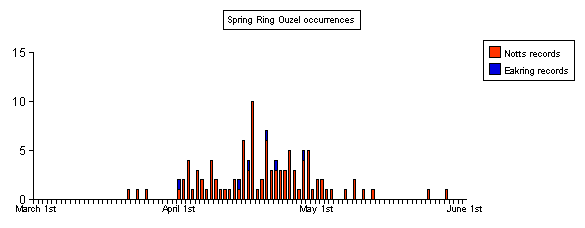 |
The graph shown on the
right depicts all Nottinghamshire's Ring Ouzel records
dating to Spring 2003. Eakring records are shown in blue
and it shows that April is the best month for Ring Ouzel.
A general peak occurs between April 20-29th, a period that usually coincides with peak numbers of Wheatears moving through the area. The two birds at Eakring in 2003, continued a relatively regular series of records here. Since a male was rung at Leyfields by Andy Chick in April 1997, a further five Spring records occurred. |
|
| .... | .... | .... |
| All were males, apart from the Kersall female
present in 1999. Clearly this is a species which passes
unnoticed at many sites, through it's generally shy and
extremely wary nature and it would seem that as in the
case of Wheatears and other chats, Ring Ouzels can turn
up just about anywhere and in a multitude of habitats.
Birds were found near Hawthorn (either scrub or hedgerow)
and there have been two which showed a preference for
Ivy-covered trees. Despite much searching each year since 1998, there were no Autumn records from the Eakring and Kersall area until a female was eventually found with a small group of Blackbirds along the old hedge at Eakring Flash on October 17th 2004. In 2007, a 1st Winter female was again with Blackbirds, feeding on Elders in a hedgerow near to Eakring Flash. |
||
| Blackbird Turdus merula |
| By far the most commonest
breeding bird within the area, with Blackbird reaching
105 pairs when last surveyed in 2000. Because of it's
high total, further counts were conducted in an effort to
confirm such a high figure. Each count revealed around
the same total, with 54 pairs at Eakring. This
represented a large increase on the original breeding
totals found in 1998. The resident population was often substantially increased by large arrivals of continental migrants. Definite influxes or arrivals were recorded at the Oil Bore Holes site on the edge of Eakring village on September 26th 1999, where at least 40+ Blackbirds fed in the Hawthorns. In 2004, large numbers of Blackbirds arrived into the area around the October 29th. Good numbers were also reported elsewhere around the UK after one of the largest influxes of recent years. By the following day, large numbers were noted in Hawthorns at Red Hill and these continued to be present until early November. There were two obvious influxes in 2007. A minimum of 23 Blackbird were in bushes at the southern-end of Eakring Flash, with numerous small groups of Blackbirds at most other sites visited on October 11th, followed by 19 Blackbird moving through in various directions and often (unusually) at height on October 21st. |
| Fieldfare Turdus pilaris |
||||||||||||||||||||
| Arrival dates 1998-2007 | ||||||||||||||||||||
|
||||||||||||||||||||
| Common as a passage
migrant and Winter visitor. Just over 32 000 Fieldfare
were recorded during both migration periods. Autumn arrivals produced only two four-figure counts in ten years. A large movement took place over several dates in early November 2000. Peak movements and dates were 1 141 west November 4th, 2 088 west November 7th and 1 027 west November 8th. The final total for October and November 2000 was 5 391 Fieldfare, but in 2006, this total was nearly equalled in one single morning. Huge numbers of Fieldfare flew west and south-west on November 2nd, with two clear waves of birds that appeared to be moving on a broad front. After just over an hour, the count had already reached 1 000, but a massive wave of Fieldfare between 08:25h and 08:35h produced just over 1 300. Fieldfare were still going through during the following hour, but the numbers gradually dropped, before yet another wave of birds began pouring through low. 09:45h-10:30h produced another 1 747, with the final total being 5 275 Fieldfare for the morning. Some large flocks built up during February-March, but rarely before much before January. Counts varied considerably following any arrival in the Autumn and the only large count made in November or December was 700, at several sites around the area on November 27th 2002. A conservatively estimated 1 500 Fieldfare were present near Parkhill Plantation on February 24th 2007, but there were other notable counts made prior to (or during) Spring migration including 1 100 on February 10th 2003, 1 114 on February 20th 1999, 800 on March 31st 2001, 689 at Tug Bridge Farm March 16th 2006 and 600 in several large flocks around the area on January 10th 2004. 1 000 Fieldfare present on January 28th 2003 included 500+ at Tug Bridge Farm, 100 at Eakring Flash and 400 near the Severn Trent works between Eakring and Wellow. Visible migration counts during the Spring produced a maximum of 783 moving north-east on the March 16th 1998. But an interesting observation of Fieldfare setting off north-east at dusk, came from the Red Hill/Lound Wood area in 2007, when 183 Fieldfare climbed high into the darkening sky heading north-east on April 5th, followed by 26 again north-east at dusk on April 6th. Fieldfare have also produced five May records, but the latest date was of a bird present near Kersall from May 7-9th 2000. |
||||||||||||||||||||
| Song
Thrush Turdus
philomelos |
||
| Becoming increasingly common as a breeding bird and showed an interesting pattern of dispersal. Just 15 breeding pairs were found in 1998, but when Song Thrush was last surveyed in 2005, the total had risen to 25 pairs. Within Eakring village itself, mapping of male territories in 2005 suggested that the concentrated population found in 1998, had thinned and spread outwards as birds moved out of Eakring village and into other sites across the area. In 1998, there were only two breeding pairs found outside Eakring village. These were at Kersall village and Hare Hill Wood to the east of the recording area. | ||
| .... | .... | .... |
|
The population totals in the above table, show the decline in the number of Song Thrushes from within Eakring village since 2002. Yet the combined total for the whole of the recording area had increased as birds colonised new areas. The loss of a great deal of the Song Thrush's favoured habitat, no doubt led to it's decline within Eakring village. | |||||||||||||
| .... | .... | .... |
| Even with the
increase in the resident population, if there had been
the same amount of suitable garden habitat in 2005 as
there was in 1998, then one would have expected counts to
(at least) have remained the same if habitat had not been
lost. Much building work was undertaken within Eakring
village during that time and some of the larger gardens
decreased as new houses were built on available, or
recently created plots. Song Thrush were also regularly recorded during visible migration watches and there were small influxes noted most years. October 2002 produced the largest influx when good numbers of Song Thrush arrived with the first Redwing and Fieldfare of the Autumn. At least 13 were along the old hedge at Eakring Flash on October 2nd, and many were noted moving through the area. 22 moving south-east but also north, included one group of eight alone on October 13th and 18 were recorded (mostly in small groups) but many were also presumed missed among the numerous Redwing flocks moving west on October 18th. |
||
| Redwing Turdus iliacus |
||||||||||||||||||||
| Arrival dates 1998-2007 | ||||||||||||||||||||
|
| A common
passage migrant. Over-wintering numbers have always been
low here and birds have always dispersed very quickly
after arrival in the Autumn. The largest arrival occurred
in 2006, when a record Redwing movement took place at the
end of the October. After 218 had gone west on October
11th, a huge movement occurred on the morning of October
26th, producing a record total of 4 540 moving mostly low
south-west, but with some flocks also heading south in
what were (for most of the time) extremely windy
conditions. There was a very early arrival at the end of September 2007, when 1 815 west on September 27th. This was around two weeks earlier than the expected arrival date. |
||
| .... | .... | .... |
| Redwing arrival on
October 17th and 18th 2002 occurred within a very small
migratory "corridor", no more than a
few hundred metres across. This corridor ran in an
east/west direction, directly over and between Lound Wood
and Little Leyfields farm. Most Winter migrant arrivals
occur on a broad scale. These are easily viewable from
any single vantage point, and scanning with binoculars
will further reveal such passage over more distant parts
of the recording area. Such was the concentration of this passage, that even scanning points both north and south with binoculars away from the main route, revealed that less than 1% of Redwings recorded over both days, strayed away from this corridor. If traditional watch points had been used (which they were for certain periods to verify the corridor) then counts would have been vastly lower than those actually derived. |
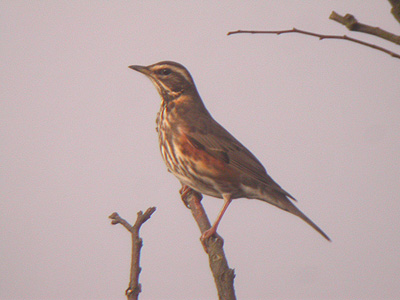 |
| .... |
| The narrowness of the
fly-over route had been quickly identified on October
17th, when 1,158 Redwing were counted from just after
first light when movements began, with small numbers of
Fieldfare, Chaffinch and Greenfinch moving through with
some flocks. It was however a surprise when 2,048 Redwing
(and increased numbers of Fieldfare) again used exactly
the same route the following day. Looking at a possible reason may loosely imply that foggy weather conditions at the time were a possible cause for such a concentration, although this is unlikely. There was some low mist/fog in the area on the first day's passage, which may have caused birds to fly over where it was thinnest (hence over higher ground) This would not explain the same route followed the following day which was clear of any mist or fog. Geographical explanations also cannot account for this route, as the area is only contoured gently and would not concentrate flocks into one particular path. If this was the case, then it would almost certainly be noted annually. After over-wintering in small numbers (usually just small groups often at many sites) Redwing produced no great visible migration counts during the Spring. 63 moving through on March 18th 1999 was the highest count involving fly-over birds, but 250 Redwing were in with Fieldfares and Starlings near Parkhill Plantation on February 24th 2007, 100+ were near Eakring Flash on January 24th 2004 and 70 were in the High Trees/Church Hill area on February 11th 2003. The area's latest Redwing date came on April 22nd 2003. |
| Mistle Thrush Turdus viscivorus |
| Fairly common with pairs breeding at several widespread sites. The 1998 breeding bird survey located a total of 11 pairs throughout the area but there was a decrease in numbers and by 2001, were down to eight pairs. The largest counts were 33 (made up of three groups) on September 13th 1999 and 34 at Eakring Flash on August 26th 2003. There was some evidence to suggest that either genuine passage or dispersing birds moved through from late August and into September. Most such birds were recorded moving in a south-westerly direction. |
| Grasshopper
Warbler Locustella
naevia |
||||||||||||||||||||
| Arrival dates 1998-2007 | ||||||||||||||||||||
|
| Occurring as a passage migrant which has become increasingly regular following a series of years producing lower numbers from 1999-2005. Arrivals occurred within an 18 day period from April 16th (2006 and 2007) through to May 3rd 2005. On April 24th 1998, a male was seen to come in from the high south, landing in dense cover at the southern-end of Eakring Flash and immediately start singing. The only multiple arrival was of three which arrived overnight on April 16th 2006. | ||
| .... | .... | .... |
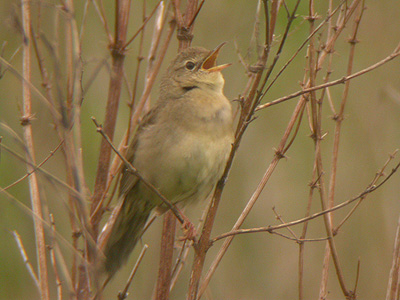 |
Grasshopper Warbler first
bred here in 2003 and one or two have been bred more or
less annually since then, reaching a maximum count of
three pairs in 2004. Breeding birds have usually remained
in the area until around late June and early July and
males which arrived in April, have started to sing
occasionally again in July. Completely new birds have turned up in mid-July and then held territory for a few days at previously unoccupied sites well away from Eakring Flash, but a very late male once arrived at Eakring Flash on June 22nd 2004 and sang till August 5th. |
|
| .... | ||
| Genuine Autumn migrants were recorded with worn looking adults at Eakring Flash from September 13-14th 1999 and at Eakring Meadows on September 5th 2002. Juvenile Grasshopper Warblers were at the Pastures on August 17th 2000 and at Eakring Flash on August 25th 2005. | ||
| Sedge Warbler Acrocephalus schoenobaenus |
||||||||||||||||||||
| Arrival dates 1998-2007 | ||||||||||||||||||||
|
||||||||||||||||||||
| Fairly common migrant.
Breeding birds became totally restricted to Eakring
Flash, after breeding there for the first time in 1999.
Following the destruction of suitable nesting habitat at
Penny Pasture Common by cattle grazing in early 2003, all
breeding became restricted to Eakring Flash. Singing males have taken up territories elsewhere at Eakring Meadows and once in ditches at Church Hill and Eakring Field Farm in 1998, but these were isolated instances. Passage birds have occurred deep within Oil-seed Rape Fields during Spring. Earliest arrival dates have shown quite remarkable consistency with all coming between April 17-26th. Main arrival in 2007 was extremely late in comparison to previous years and after the first Sedge Warbler on April 22nd, there were no further records until May 3rd onwards. Breeding birds have always been quick to vacate the area, becoming extremely scarce and rarely observed unless second broods have been raised, from late June/early July. Migrants were most frequently recorded during the early Autumn. From 1998-2007, monthly totals included 50 birds in August and 13 in September, with the latest record coming on September 15th 2000. Late migrants appearing in September were often found to be indicative of a much broader arrival of common warblers and arrivals often coincided with late Reed Warblers. |
||||||||||||||||||||
| Reed Warbler Acrocephalus scirpaceus |
||||||||||||||||||||
| Arrival dates 1998-2007 | ||||||||||||||||||||
|
||||||||||||||||||||
| Formerly occurred only as
a rare passage migrant, but has bred here since 2005.
Prior to Reed Warblers breeding here, a single bird along
the old hedge at Eakring Flash on April 23rd 2000, was
the only Spring record. Breeding was first recorded at
Eakring Flash in 2005 and at least one pair has bred
annually since. Most Autumn Reed Warblers have occurred during late August/early September. Mid-August has also produced several records, before a series of late occurrences in mid-September. If records for genuine migrant Sedge Warblers (rather than locally breeding birds) are considered, then there seems evidence for a direct association between the two species during return migration. Indeed, both species have been found in the same bush during mid-September. This could of course be coincidence due to the number of birds moving through at this time, but numbers of many of the other warblers peak during mid-August. |
||||||||||||||||||||
| Lesser
Whitethroat Sylvia
curruca |
||||||||||||||||||||
| Arrival dates 1998-2007 | ||||||||||||||||||||
|
||||||||||||||||||||
| Largely recorded as a passage migrant. A small number of pairs bred annually from 1998-2002, but there has been a steady increase and in 2007 eight pairs bred. A number of breeding sites have been used annually and many of these are situated along roadside hedgerows. It was during Spring and Autumn passage, that most Lesser Whitethroat were recorded. The largest Spring monthly count was 13 birds in April 2000. |
| .... | ||
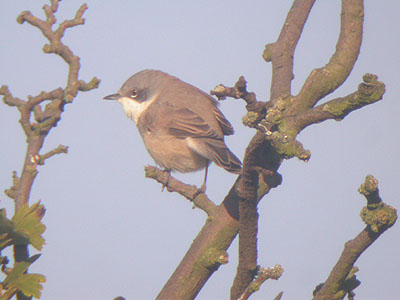 |
Two especially good
periods were the Autumn of 1999 and a few years later in
2002. A total of 40 migrant Lesser Whitethroat passed
through the area during August and September 1999,
including the largest single arrival of 11 on September
5th. During the same two months in 2002, some 52 migrants
were recorded. Although there was no single large arrival, the ratios of adults/juveniles present each day, showed the number of birds involved was much higher than at first glance. The most significant period was September 4-11th, part of which coincided with a huge fall of warblers on the east coast on September 9th. The latest Lesser Whitethroat was at Penny Pasture Common on September 29-30th 2007. |
|
| .... | .... | .... |
| Whitethroat Sylvia communis |
||||||||||||||||||||||
| Arrival dates 1998-2007 | ||||||||||||||||||||||
|
||||||||||||||||||||||
| A common passage migrant, breeding in good numbers. Little variation has also been shown in earliest arrival dates. 2003 and 2004 aside, the first Whitethroats always arrived within a five day period from April 20-24th. Large numbers of passage birds were recorded annually, but 228 birds in 2002 was by far the highest count. As shown in the accompanying graph, peak Whitethroat counts came during August, but birds were common well into September. The highest ever single counts was 17 on August 28th 2002 and the latest date was October 3rd 1999. | ||
| .... | .... | .... |
| The 1998 breeding bird
survey found a total of 43 pairs across the area and
Whitethroat continued to be successful over the next ten
years, showing relatively little variation in the number
of breeding pairs. The majority of territories were along trimmed roadside hedgerows, especially where there was some Bramble or Nettle growth. Overgrown hedgerow habitats were rarely favoured for nesting, but used during migration periods. |
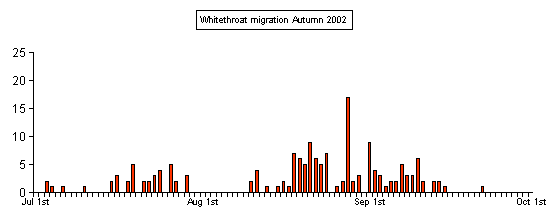 |
|
| .... | ... | .... |
| Garden Warbler Sylvia borin |
||||||||||||||||||||
| Arrival dates 1998-2007 | ||||||||||||||||||||
|
||||||||||||||||||||
| Rare as a breeding bird
and passage migrant. This has always been a rare breeding
bird with a tenuous population. The 1998 survey found
just three breeding pairs and little changed over the
following years. Two pairs were found in 2002 and in 2007
there were four pairs at widely scattered sites. Garden Warbler proved to be one of the latest warblers to arrive in Spring and arrival dates were never recorded before April 26th until a very early bird arrived on April 23rd 2007. As a passage migrant, this species remained very rare and only produced a mere five records. The three July records could possibly have related to locally dispersing birds, meaning that there were just two definite migrant Garden Warblers between 1998 and 2007. These were at Eakring Flash on August 28th 2002 (part of a good arrival of warblers that morning) and at Penny Pasture Common, Eakring Meadows on September 11th 1999. There were no post-June records at all after 2003. |
||||||||||||||||||||
| Blackcap Sylvia atricapilla |
||||||||||||||||||||
| Arrival dates 1998-2007 | ||||||||||||||||||||
|
||||||||||||||||||||
| Common passage migrant,
but often produced few records during the Autumn and in
some years was scarce after July. Examples of this were
2000, 2003 and 2007. Peak migrant numbers came in
September and there were good numbers of Blackcap (36) in
September 2001 and then 31 in September 2002, following a
large arrival of warblers along the east coast. Spring
counts were always significantly higher. The 1998 breeding survey found 34 pairs at many localities across the area, but this dropped considerably in 2007 when Blackcap had a very poor year. As with most other warblers here, the number of terriotires males could occupy was restricted through habitat availability. |
||||||||||||||||||||
| Chiffchaff Phylloscopus collybita |
||||||||||||||||||||
| Arrival dates 1998-2007 | ||||||||||||||||||||
|
||||||||||||||||||||
| A common passage migrant,
breeding in varying numbers. Just 15 pairs bred in 1998,
but this crashed to just four pairs in 1999. The
following year saw a slight rise to six pairs. By 2001
Chiffchaff was back up to 11 pairs and totals remained
similar to 2007. In 1998, I spent a great deal of time observing the territorial duration of male Chiffchaffs in Spring. It was found that from 1998-2007, the year's first three male Chiffchaff to hold territory for any length of time (not including brief hedgerow migrants) all returned to the same two sites. These were at High Trees (1 male) and Hare Hill Wood (2 males) Whether these were the same birds remains uncertain, but it is likely that they were for several years at least. |
| .... | .... | .... |
| These two sites offered
perfect Chiffchaff habitat, both being wooded and with a
thick under-storey. When these two sites were fully
occupied by male territories, later arrivals seemed
forced to establish territories in less suitable
habitats, unless a previously occupied territory is
vacated by a male unsuccessful in attracting a female.
Most other sites in the area that hold singing males were usually dense/overgrown areas of scrub, large gardens or small Willow copses. Apart from one male Chiffchaff in 1998, available territories in Lound Wood remained completely vacant until 2001. Right:- The territorial durations of male Chiffchaffs during Spring 1998. |
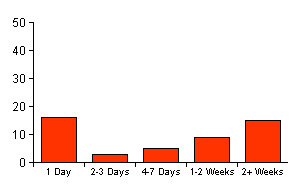 |
|
| .... | .... | .... |
| Male Chiffchaffs sang almost daily when in territory (each one present in the area during 1998, being checked daily for continued presence) Territories could be occupied for a day, but more often than not, for up to a week or much longer. This depended on the male's ability to attract of a female, but I found that a Chiffchaff singing in one spot on April 3rd, may not have been the same bird singing there a few days or even a week later. | ||
| .... | .... | .... |
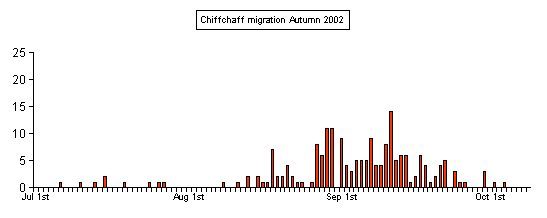 |
Chiffchaff was very common as a passage migrant. Good years came in both 2002 and 2007, with a record 105 Chiffchaff recorded passing through in September 2002 alone. This turned out to be a massive total in comparison to the same month in most other years and was largely attributed by the huge east coast fall of migrants on September 9th, which led to above average numbers of Chiffchaff in the Eakring area on September 11th. September 2007 produced 92 Chiffchaff out of an Autumn total of 111 birds. | |
| .... | .... | .... |
| Typically,
the latest dates for Chiffchaff were limited to the
period October 8-20th. A bird in an Eakring garden on
November 4th 2001 was the latest ever (apart from the abietinus bird of November
16th 2003) but was
considered to be an over-wintering bird, rather than a
late migrant. A Chiffchaff wearing a silver BTO ring was recorded on September 5th 2002, but one of the most interesting birds seen was a very interesting, strikingly brown and white Chiffchaff at Penny Pasture Common on September 1st 2001. It had an extremely well defined supercillium which was so distinct, my attention was drawn to it even in flight. |
||
| Chiffchaff Phylloscopus
collybita abietinus (North Fenno-Scandia race)
|
| One was present in Sallow scrub, at the southern end of Eakring Flash on November 16th 2003. |
| Willow Warbler Phylloscopus trochilus |
||||||||||||||||||||
| Arrival dates 1998-2007 | ||||||||||||||||||||
|
||||||||||||||||||||
| A common passage migrant
and breeding bird. The number of breeding pairs rose from
20 in 1998 to 26 in 2001. Breeding was not recorded at
Eakring Flash until scrub growth had substantially
increased in May 2003, but Willow Warblers have since
bred there annually. Typical arrival dates for the first
Spring birds was April 4-8th, although birds arrived
later in 2004, 2006 and 2007. April 3rd 2005 was the
earliest date. Migrants have always been common, but there was a slight decrease in numbers during 2006 and 2007. August represents the month for peak numbers, but there was an early return in July 2002. Records are much less common in September and the latest Willow Warbler here was back on September 21st 1998. |
||||||||||||||||||||
| Goldcrest Regulus regulus |
| Common, but a rare breeding bird which was restricted through habitat. One (occasionally two) pairs nested in Lound Wood, but gardens in Eakring village have also provided records of successful breeding. The first Autumn birds moved through in late September, with further migrants being noted well into November. Small numbers over-wintered each year. |
| Firecrest Regulus ignicapillus |
| A male was in Hawthorns at the southern-end of Eakring Flash on May 7th 2001. The bird was seen well and at close range for a few minutes and stayed for about 15 minutes, remaining in the same bush for the whole time and occasionally singing. It flew off along the hedgerow and further into the pastures area, where I thought it would be fairly easy to relocate, but it was never seen or heard again. |
| Spotted
Flycatcher Muscicapa
striata |
||||||||||||||||||||
| Arrival dates 1998-2007 | ||||||||||||||||||||
|
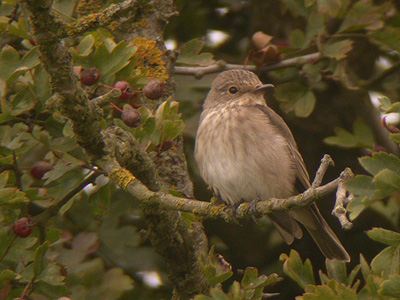 |
Spotted Flycatcher was
always the latest of the Summer migrants to arrive. The
earliest arrival was on May 8th 2006, but there were
three years when no migrants were recorded during Spring
migration. On average, arrival was around mid-May. After four pairs bred in 1998, Spotted Flycatcher became much rarer as a breeding bird during the early 2000's and breeding was confined to just a single pairs at Eakring village, when nest sites found were situated in walls at Ryall's Farm and at a private site. Breeding was not proven in all years and some first Spotted Flycatchers of the year, were not seen until the first of the Autumn migrants. |
|
| .... | .. | .... |
| There was a large overnight arrival of 14 Spotted Flycatchers on August 22nd 1999. This total included eleven together at Eakring Meadows, two at Eakring Flash and a single bird was in trees at Red Hill. The area's latest ever Spotted Flycatcher was on September 19th 1998. | ||
| Long-tailed Tit Aegithalos caudatus |
| Common. Between six and eight pairs bred. Long-tailed Tits did especially well in 2007, breeding earlier and successfully fledging young before many other species. The highest count was of 32 birds, with groups at Red Hill (22) and Eakring village (10) on September 26th 1999. An unusual observation (and only ever seen on the one occasion) was the group of seven Long-tailed Tits that dropped in from high, at Red Hill on October 14th 1998. |
| Marsh Tit Parus palustris |
| A population of just two pairs bred in 1998, but only one pair bred at Hare Hill Wood in 1999. Two pairs were located during 2002, but Marsh Tit remained a very rare breeding bird until 2007 when three pairs bred at High Trees, Lound Wood and Hare Hill Wood. This species seemed far more sedentary than Willow Tit, though they could range over quite large areas when associating with feeding tit flocks outside the breeding season. There were just two records of birds along the old hedge at Eakring Flash. |
| Willow Tit Parus montanus |
| Found to be only slightly more common than Marsh Tit, with three pairs at Lound Wood, Hare Hill Wood and the Oil Bore Holes site at Eakring village during 1998, dropping to just one pair in 1999. There was only the slightest increase throughout the rest of the period. In 2007, pairs were at Lound Wood, High Trees and Hare Hill Wood. Willow Tits were regularly seen at other sites in the area. |
| Coal Tit Parus ater |
|
| There has been a very
small resident breeding population since 1998, with Lound
Wood holding a pair every year apart from 2001. Single
pairs occasionally bred in gardens around Eakring
village. Coal Tits were more commonly noted moving through the area during the Autumn, with much smaller numbers moving north in the early Spring. Whilst none of these ever showed any characteristics of the continental race, Coal Tits clearly disperse or make short migratory movements each Autumn. 25 birds moved through in 2001, making this the best year, but there were also higher than average migrant totals of 13 in 1998, 17 in 2002 and 12 in 2005. |
|
| Blue Tit Parus caeruleus |
| Very common, but showed a drop in numbers. 34 breeding pairs were found in the 1998 survey, but when the species was next surveyed in 2001, the breeding population had dropped to 22 pairs. |
| Great Tit Parus major |
|
| The number of sightings and breeding pairs dropped from 21 pairs in 1998 to just 13 pairs in the 2001 breeding survey. Casual observations appeared to show that by the end of 2007, Great Tit had possibly declined even further. | |
| Nuthatch Sitta europaea |
| Nuthatch was always rare here. Apart from one-two birds which were at Lound Wood from November 2002-January 2003, there were just five records. These included singles in the pastures area on June 22nd 2001, moving south-west over Eakring Flash on September 21st 2002, south-west over Eakring Flash on October 16th 2003 and singles at Hare Hill Wood on September 1st and Lound Wood on September 30th 2007. |
| Treecreeper Certhia familiaris |
| A total of five breeding pairs were found in Lound Wood and Hare Hill Wood during the 1998 breeding bird survey. Occasional wandering birds turned up at many sites (including isolated trees) and sightings were extremely unusual at Eakring Flash. |
| Great Grey Shrike Lanius excubitor |
| One was
present along the old hedge at Eakring Flash from 08:30h-08:45h on October 17th
2004 and was found by Robin Brace. It initially showed well, but then moved off west and was lost to view. It was later relocated in the Red Hill area at around 10:15h, in the hedgerow alongside the conservation walk that starts from the Eakring to Wellow minor road, about 0.75 mile north of Eakring village. It was again mobile and flew off across the large field that runs down the hill, away from walk start point and became lost from view and was never relocated later in the afternoon despite much searching. |
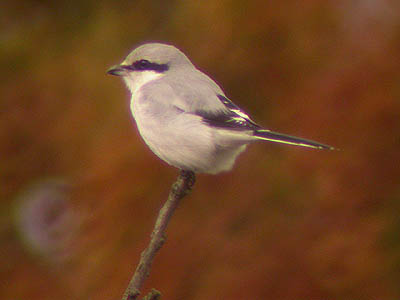 |
|
| .... | ||
| Jay Garrulus glandarius |
|
| Relatively common,
especially during the Autumn months when birds move
through the area. Breeding Jays were restricted to just a
single pair at Hare Hill Wood from 1998-2000, after which
there were no further breeding attempts until new pairs
held territories at both Hare Hill Wood and Lound Wood
from 2005. Although there is little evidence suggesting that Jays actually migrate long distances, some form of south-westerly dispersal by local birds did take place every Autumn. The first began to move through from late August through to October. Some 19 migrants went south-west during September and October 2007, equalling the number of birds during the same months in 2003. Jays were also noted moving north during the Spring. Four in May 2002 and eight in April 2006, were the best of the monthly migration totals. |
|
| Magpie Pica pica |
|
| Common. There were no excessive counts made. Ten pairs were found breeding in the 1998 survey. | |
| Jackdaw Corvus monedula |
| Recorded daily. There were 25 breeding pairs in the area during 1998, most at widely scattered sites. Jackdaws constantly competed with two Little Owl pairs for their nest holes, and were eventually successful. |
| Rook Corvus frugilegus |
| Extremely common and seen
daily in numbers as birds commute over the area to
Bilsthorpe Tip. The Rookery at Leyfields revealed 58
nests in 1998, but had increased by 2000 when occupied
nests totalled 62. This was a small rise on previous
figures and there were further nests in a new site at
Parkhill Plantation, where seven pairs bred successfully.
The Rookery was created by a spill-over from the site
nearby at Maplebeck, but it was only used in 2000. 600 birds on July 30th 1999, remained the highest count. |
| Carrion Crow Corvus corone corone |
| Common with six pairs breeding in 1998. A group of 36 birds together on February 2nd 1999 was extremely unusual. |
| Starling Sturnus vulgaris |
||
| A common breeding bird, but in lower numbers than expected. The breeding pair population ranged between 18 pairs in the 1998 breeding bird survey, 19 in 2000 and then 18 in 2007. Migrant Starlings were recorded in large numbers during Autumn passage from the continent. Just over 39 000 birds were recorded from September-November in 1998-2007. Peak years for movements were 1998, 2000 and 2001, but there were two relatively poor years in 2004 and 2005. Movements in Spring were more subdued, with no high counts ever made. Spring movements usually occurred from mid-February through to late March, dependant on the weather conditions in the early part of the year. |
| .... | .... | .... |
 |
||
| .... | .... | .... |
| The graph shows the two main periods of Starling migration during 1998 and 2007. The biggest Starling movements have all come in November, with only one four figure count for October. Starlings also moved through in good numbers in November 1998 and had it not been for work commitments, the daily counts would probably have been much higher. Four figure counts were reached on three days early in the month, with the best being 1 708 west on November 7th with another 1 701 west the next day. In November 2000, daily totals never beat the 1 000 mark, but again there was a very large accumulative Autumn passage total of over 7 000 birds. 2001 saw over 8 300 migrants pass through during the Autumn, with best totals being 1 031 west on October 17th, 1 901 west on November 10th and another 1 013 west on the 11th. | ||
| House Sparrow Passer domesticus |
| The 1998 breeding survey produced a total of 73 pairs at both villages and all the farms within the area, with the total number of breeding pairs at Eakring village being 43 pairs. House Sparrows were found in close proximity to buildings, with both villages supporting good populations. Leyfields, Tug Bridge, Park and Eakring Field Farms all had small and relatively isolated populations, which through regular observation, seemed totally sedentary for much of the year. | ||
| .... | .... | .... |
| Away from these sites
there was just one record, of a male around the old
building at Church Hill back in 1998. Although they must
obviously wander from these farms more frequently than
have actually been recorded, House Sparrows have never
been noted in purposeful/dispersal flight across open
country here in over ten years. Post-breeding flocks have been found to be more active around July, when they feed along hedgerows around the outskirts of both villages and all of the farms. Populations from the nearest farms are presumed to mix with those of the villages during this time. One particularly large flock between Eakring village and Eakring Flash held 158 birds on July 25th 1998. |
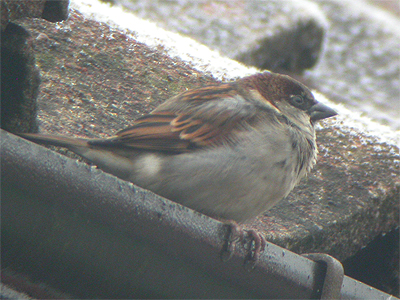 |
|
| .... | .... | .... |
| In early January 2008 I surveyed the Eakring village population once again. A minimum total of 130 House Sparrow were recorded during the survey. This would mean an estimated breeding figure of around 50-60 pairs and represent a surprisingly large and unexpected rise on the 43 pairs found in the 1998 survey. | ||
| Tree Sparrow Passer montanus |
| Formerly a scarce resident with never more than three pairs breeding. For several years (1998-2001) Tree Sparrow flocks were outnumbered by small numbers of passage migrants during the Autumn. There was a substantial increase in the number of semi-resident birds and post-breeding/over-wintering flocks from 2002-2003, although the number of breeding Tree Sparrows in the area has remained extremely low. | ||
| .... | .... | .... |
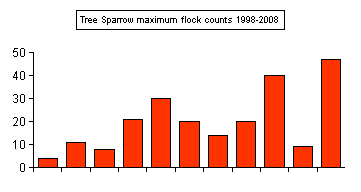 |
Natural nesting sites
remained plentiful and most of those currently used by
breeding birds were occupied on an annual basis for
several years. One such site at Tug Bridge Farm has been
occupied since a pair set up territory in 2000. Although the acreage of set-aside fields never really changed between 1998 and 2002, the increase in Tree Sparrow numbers from after that time, is thought most likely to be attributable to the substantial increase in the planting of set-aside strips through the Stewardship Scheme. These remained in use over a large part of the area until 2007, but some may be removed in the coming years as part of the UK Government's relaxation of set-aside policies and guidelines. |
|
| .... | .... | .... |
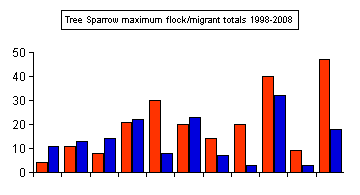 |
The top graph shows the
maximum flock counts from 1998-2007. The general increase
in numbers is evident and I checked to see if there is
any correlation between the increase in Tree Sparrows
flock totals and the number of Tree Sparrows recorded
during visible migration watches in the Autumn. Whilst there were some obvious similarities between the two graphs, when the total number of Autumn migrants from August-November was used, there was very little correlation when only the figures for August and September were used. |
|
| The majority
of the highest Tree Sparrow counts were largely
attributable to post-breeding flocks found in the area
during August and September. At this time of the year,
"pure" flocks of Tree Sparrow occur, but later
in the Autumn and continuing throughout the Winter
months, Tree Sparrows tended to associate with a variety
of other species. Based entirely on observations from
1998-2007, these two species were primarily Chaffinch and
Yellowhammer. The highest ever counts came in 2006, with 35 (two flocks) near Eakring Flash and at Penny Pasture Common on August 22nd and 40 at Eakring Field Farm/Penny Pasture Common on September 9th. Good years for Tree Sparrow passage were 2001, 2003 and 2006. |
||
| Chaffinch Fringilla coelebs |
| Very common breeding
species with counts of 52 pairs in 1998, rising
dramatically to 84 pairs in the 2000 breeding bird
survey. Very few Chaffinch were ever noted during Spring
passage, but there were several years when good numbers
passed through during the Autumn. Peak movements always
came during October, although there were three figure
monthly totals for September 2000 and 2001. A total of
over 4 500 Chaffinches had been recorded via visible
migration watches to the end of 2007. Although the Autumn total of 851 Chaffinch in 2001 remained a record throughout the ten years coverage, the Autumn 2007 count of 559 Chaffinch, represented the area's best ever period of movement. With coverage possible on just two/three mornings a week, then this would be the largest ever monthly movement of Chaffinches over the area if daily coverage had been possible. There had never been a single morning count before, that had ever reached three figures and yet there were three instances of this in October, with counts of 118 west on October 11th, 103 west on October 14th and 116 west on October 21st. What made this Chaffinch movement even more interesting, was that there had also never been such a pronounced westerly directional movement before (birds normally moved south or south-east here) with many birds also moving through at height. Groups of Chaffinches sometimes numbered well over ten, with two flocks of 19 being the largest single flocks recorded. The movement coincided with, or followed shortly after huge numbers had been noted at some coastal watch points. Chaffinches have rarely been present during the Winter months in any numbers. The only exceptions to this were a minimum of 450 in the area on December 8th 2002, including up to 250 in the Kersall/Hare Hill Wood areas and 200 at Red Hill. 300 Chaffinch were at Kersall on February 4th 2003 and 130 were in fields at Park Farm on February 6th 2004. |
| Brambling Fringilla montifringilla |
||||||||||||||||||||
| Arrival dates 1998-2007 | ||||||||||||||||||||
|
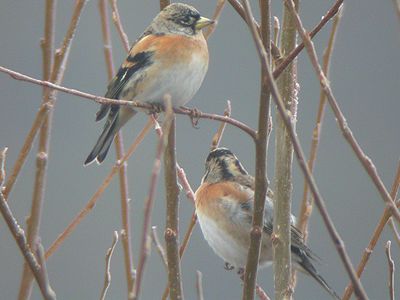 |
This Winter visitor was
surprisingly uncommon at Eakring as a passage migrant,
with true Winter records even rarer. There were just four
records coming in December and January. Arrival was
usually in early October, but slightly earlier in 2000
(September 29th) and 2007 (September 27th) Spring migrant numbers were very low and there were no big movements recorded at all in any Autumn. Best of the monthly totals was 26 in October 2003, which was one of the better Brambling years producing 52 birds. The only two other years that produced more than 30 birds were 2000 and 2001. 19 moving north over Eakring Flash on October 13th 2003, was the highest daily count. |
|
| .... | .... | .... |
| Greenfinch Carduelis chloris |
| Common resident and
passage mogrant. A total of 21 pairs were found during
the 1998 breeding survey, all of these in Eakring and
Kersall villages. No pairs were found away from these
sites. The largest single count was of approximately 100
on November 4th 1998. Spring migration was rather flat and drawn out than most other finches, with no pronounced peak ever recorded. Limited daily passage occurred during the second and third weeks of March, with movement almost negligable on some days but still continuing until mid-April. Autumn counts were better, with a peak occurring in the first half of October. Movements from September-October had a more southerly bias than those in early November, when birds typically moved west. The biggest movements were 66 moving west on October 15th 1998, 52 west on October 13th and 50 south-west on October 26th 1999, 57 west on October 13th 2000, 59 south and south-west on September 30th 2001, 73 west on October 17th 2002 and 40 west on October 8th 2006 |
| Goldfinch Carduelis carduelis |
| Regular passage migrant
during Spring and Autumn, but quite scarce as a breeding
bird. Only eight pairs bred in 1998, mostly around
Eakring village. Despite poor breeding totals, there were
several good post-breeding flocks with 60 at Eakring
Flash on August 22nd 1998, 67 in the area on September
11th 1999 and 77 (43 at Eakring Flash and 34 at Penny
Pasture Common) on September 4th and 75 at Penny Pasture
Common on August 10th 2007. Spring passage was almost daily from March-May, but counts did well to reach double figures. Whilst Autumn produced much bigger monthly totals, daily movements were rarely above 20 birds and the best of the counts was 29 south-east and south-west on October 15th 1998. There was a huge movement involving 296 Goldfinch through the area in October 2001, which was more than 200 more any other monthly total. |
| Siskin Carduelis spinus |
||||||||||||||||||||||||||||||
| Arrival dates 1998-2007 | ||||||||||||||||||||||||||||||
|
||||||||||||||||||||||||||||||
| Recorded only as a passage migrant with peak movements in October, although Siskins usually appeared from mid-September, through to late November. Occasional movement was also recorded in December. Autumn 2001 and 2002 were easily the best years for Siskin numbers, producing counts of 293 and 157 respectively. Daily movements were typically poor and the highest counts were 36 moving south on September 30th, with two further counts of 29 on both October 24th and 26th 2001 and 23 south-east on December 24th 2002. | ||||||||||||||||||||||||||||||
| Linnet Carduelis cannabina |
| Common passage migrant. A
breeding population of 21 pairs in 1998 was maintained.
There was a slight drop in the number of breeding pairs
in 2000, believed to be due to the weather. Linnets were
uncommon during the Winter months and there were only
occasional records of small flocks or groups that
remained in the area from the previous Autumn. The
largest of these were 170 near Eakring Flash on February
16th and then 150 present from February 19-21st 2002.
Large flocks were more frequent in stubble fields during
the Autumn. There were flocks of at least 250 in the
Eakring Field Farm/Parkhill Plantation area August 25th
2003, 300 at Church Hill on September 29th 2000, but the
largest came in 1998 with 450 in stubble fields at Red
Hill on September 19th and 800 at Church Hill on
September 26th 1998. Three figure counts of passage birds included 103 south-east on September 28th, 111 south on September 29th and 169 south and south-east October 4th 1998. 147 flew south and south-east on October 3rd and 140 south and south-west on October 10th 1999, with 130 south on October 8th 2006. 322 south and south-east on September 29th 2000 was easily the largest. 2000 produced an excellent Linnet passage with well over 1 000 birds. Similarly good years came in both 1998 and 2001. |
| Twite Carduelis flavirostris |
| There were just three records. Two flew in from the north and landed briefly in stubble fields at Red Hill on October 14th 1998, three flew south over Eakring Flash on October 13th 2000 and one flew south-east over Eakring Flash on October 15th 2001. |
| Lesser Redpoll Carduelis cabaret |
||||||||||||||||||||||||||||||
| Arrival dates 1998-2007 | ||||||||||||||||||||||||||||||
|
||||||||||||||||||||||||||||||
| Regular passage migrant.
It was the Autumn that produced the largest totals, with
2001 being relatively exceptional in that it was the only
year to provide a three figure count. Passage commenced
from around the third week of September, often a day or
so later than Siskin. Peak movements always occurred
during October, with the largest single counts being 20
south on October 15th 1999, 21 south and south-east on
October 30th 1999, 26 south on October 9th and 39 south
on November 9th 2000. There was one record in July 2007.
Lesser Redpoll have only ever been found during the
Winter in small groups. Very few Spring passage birds were ever recorded, but passage was certainly recorded from February-May. A flock of 35 feeding in Birches at Hare Hill Wood on April 28th 1999, was extremely unusual. |
||||||||||||||||||||||||||||||
| Common Crossbill Loxia curvirostra |
| A total of eight records. One moving south-west over Eakring Flash on August 17th and a male moving north-west over Eakring Flash on September 1st 1999, a single moving south-west over Eakring Flash on October 24th and one moving west over Eakring Meadows on December 2nd 2001. A male landed briefly at Eakring Flash to drink, then headed off north on October 26th 2003, two moving south-west over Eakring Flash on July 21st 2005, a male flying east over Eakring Flash on March 19th 2006 and a group of six flying north over Eakring Flash on August 23rd 2007 |
| Bullfinch Pyrrhula pryyhula |
| A small, but widespread
breeding population of between three and four pairs were
recorded annually. Pairs were regularly recorded at
Eakring Flash, the Oil Bore Holes and High Trees areas of
Eakring village, near Kersall and at Eakring Meadows
during the Winter months. Bullfinch were extremely
sedentary and rarely recorded here (only twice between
1998-2007) flying high over open countryside. I never
observed them during visible migration watches conducted
at any sites, flying through in the manner associated
with most finches on migration. A group of three males arrived at Eakring Flash from the high north on November 4th 2002 and four (two males and two females) were present briefly at Eakring Flash along the old hedge, before flying off west over Red Hill. An hour later, another female arrived in from the north-east on October 28th 2003. |
| Hawfinch Coccothraustes coccothraustes |
| One moving south over Eakring Flash on August 31st 1999, was the only record. |
| Yellowhammer Emberiza citrinella |
| A maximum of 37 breeding
pairs were found in the 2002 breeding bird survey, rising
from a count of 30 breeding pairs in 1998. The use of
set-aside strips proved extremely beneficial to this
farmland species. However, Wintering counts were varied
and particularly large counts were quite rare. All of the
counts listed below were from areas of set-aside. 54
(coming to seed) at Eakring STW on January 11th 2003, 80+
in set-aside near Penny Pasture Common on November 27th
2004, 100 in set-aside at Eakring Flash from January
21-26th 2002 and 42 were in set-aside field at Eakring
Flash on November 16th 2006. At Eakring Flash in early
1998, a Yellowhammer flock built up from 30 on February
10th, to a maximum of 115 by March 13th. Passage Yellowhammers were recorded in small numbers each Autumn, but 33 moving south-west on October 8th 2006, was an exceptional total that beat all other single day counts. The peak dates for migrants was usually mid-late October, but occasionally in November. Most movements may be attributable to dispersal movements, though genuine long-distance migrants certainly do occur. |
| Reed Bunting Emberiza schoeniculus |
| Common, but much more
restricted than Yellowhammer through habitat, although
odd pairs were recorded nesting well away from
traditional breeding areas like Eakring Flash and Penny
Pasture Common. A total of just eight pairs bred in 1998,
but this figure rose to 14 in the 2002 survey. The bulk of passage Reed Bunting records came during the second and third week of October, although migration continued from late September until the middle of November. Counts were always smaller than Yellowhammer and peak numbers were also recorded slightly earlier. No large counts were made. |
| Lapland Bunting Calcarius lapponicus |
| Recorded once, when two flew south over Eakring Flash at 08:26h on November 13th 2003. |
| Corn Bunting Miliaria calandra |
| Corn Bunting represents
Eakring's rarest farmland species. Between 1998 and 2007,
this bird only ever occurred here as a passage or
dispersal record, but it's status changed considerably
after 2003. There have been a total of just 19 records. Most of these related to single birds, with two records involving groups of eight and nine birds being the only exceptions. Corn Bunting was annual here until 2003, which incidentally, was one of two relatively bumper years for records. 1999 produced a total of six different records, with 2003 producing five. Since this last bumper year, Corn Bunting has not been recorded at all. On reviewing the records, a clear picture of Corn Bunting movements over the area emerged. The graph only depicts the actual records, rather than the total number of birds. From a single January record, a peak is later reached in April. Corn Buntings away from this March-April period are unusual. |
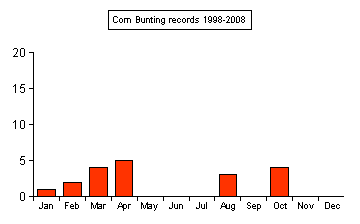 |
|
| .... | .... | .... |
| Perhaps surprisingly, there are no records for
September, yet there are three from August and four from
October. The three October records I have for Corn
Bunting here, do fall in very nicely with the migration
pattern of both Reed Bunting and Yellowhammer. These two
species have produced peak migration counts during the
second week of October, but there is a difference within
directional movement. Corn Bunting records were, one moving north on March 29th and one at Eakring Flash on April 30th 1998. One on February 20th, one moving east on March 14th, one moving west on April 4th, one flew east over Eakring Flash/relocated near Eakring Meadows on August 11-12th, eight moving west on October 13th and one at Eakring Meadows on October 14th 1999. In 2000 there was one at Eakring Flash which flew off south-west on March 26th, two moving north-east on April 28th, one moving west on August 20th and one moving north-west on October 21st. There were just two isolated records the following years, with one moving south-west on April 29th 2001 and one moving east on April 16th 2002. Nine moving west on January 27th, one moving west on February 9th, one moving north-west March 29th, one moving south-west August 31st and one moving north-west October 16th 2003, were the last records. Passage Corn Buntings have shown much more variation than either Yellowhammer or Reed Bunting during both migration periods. There seems to be no distinct seasonal movements by this species that get picked up annually by visible migration enthusiasts and probably many of the records here, would refer to wandering or dispersing birds, rather than anything else. |